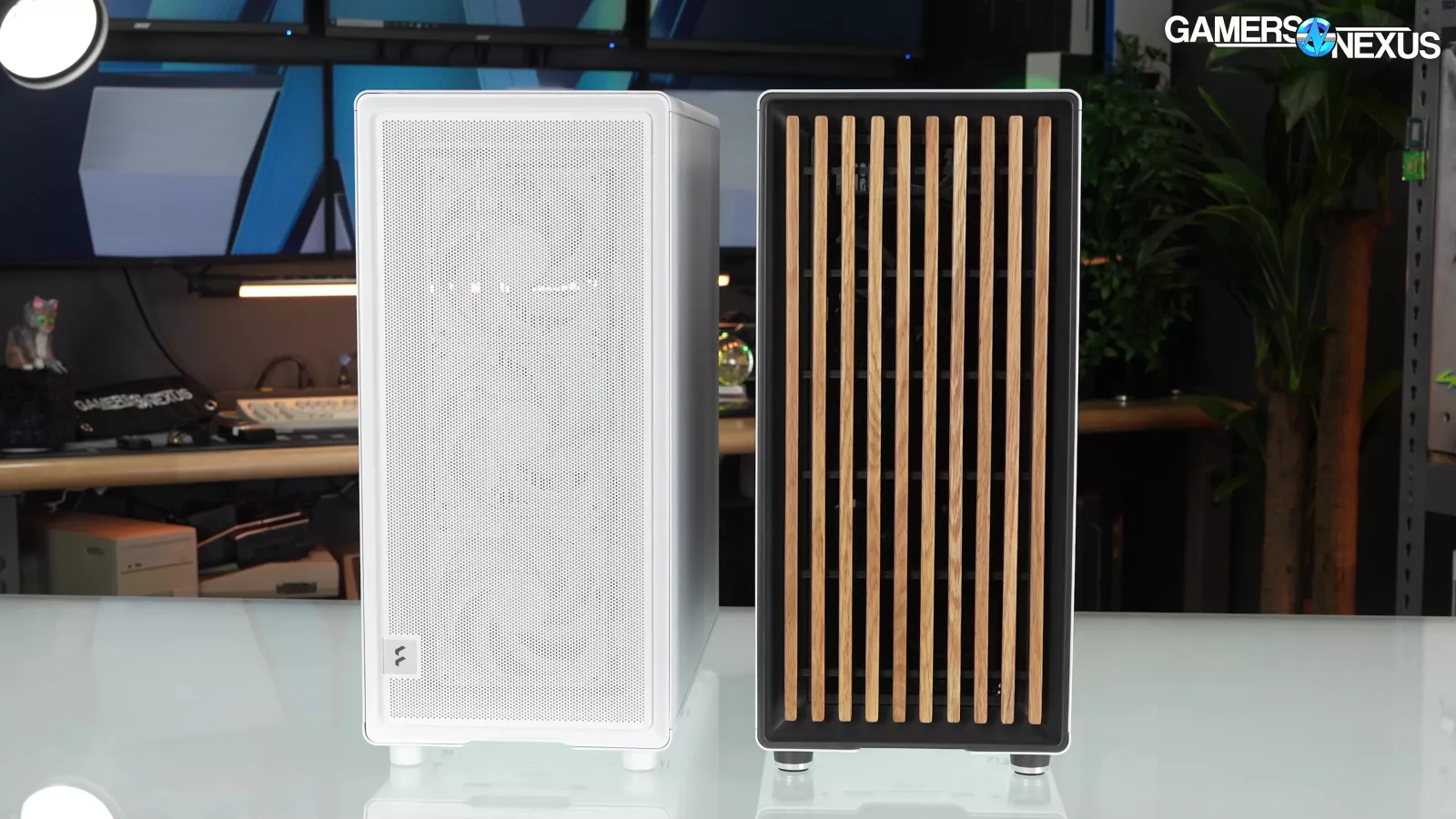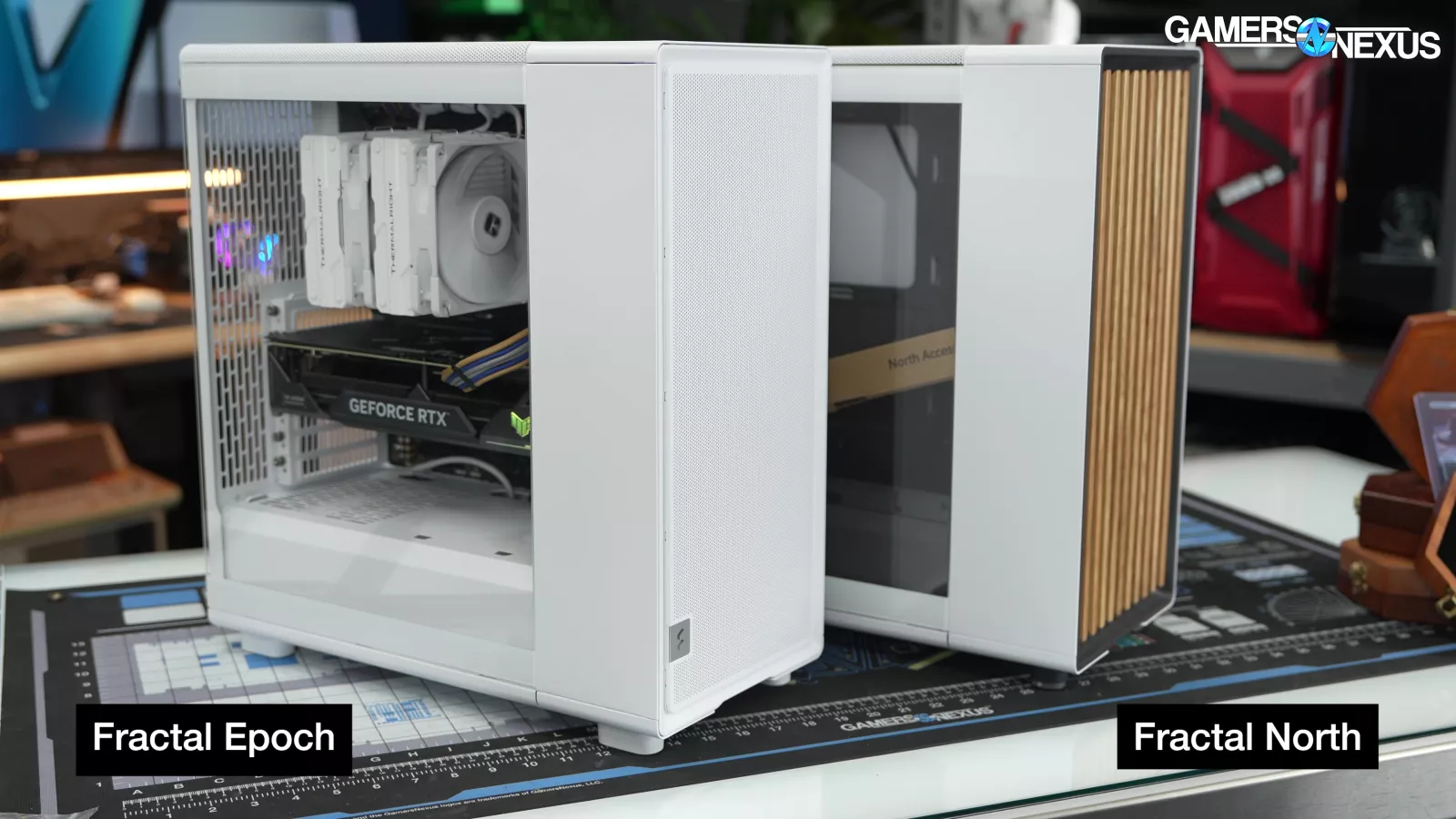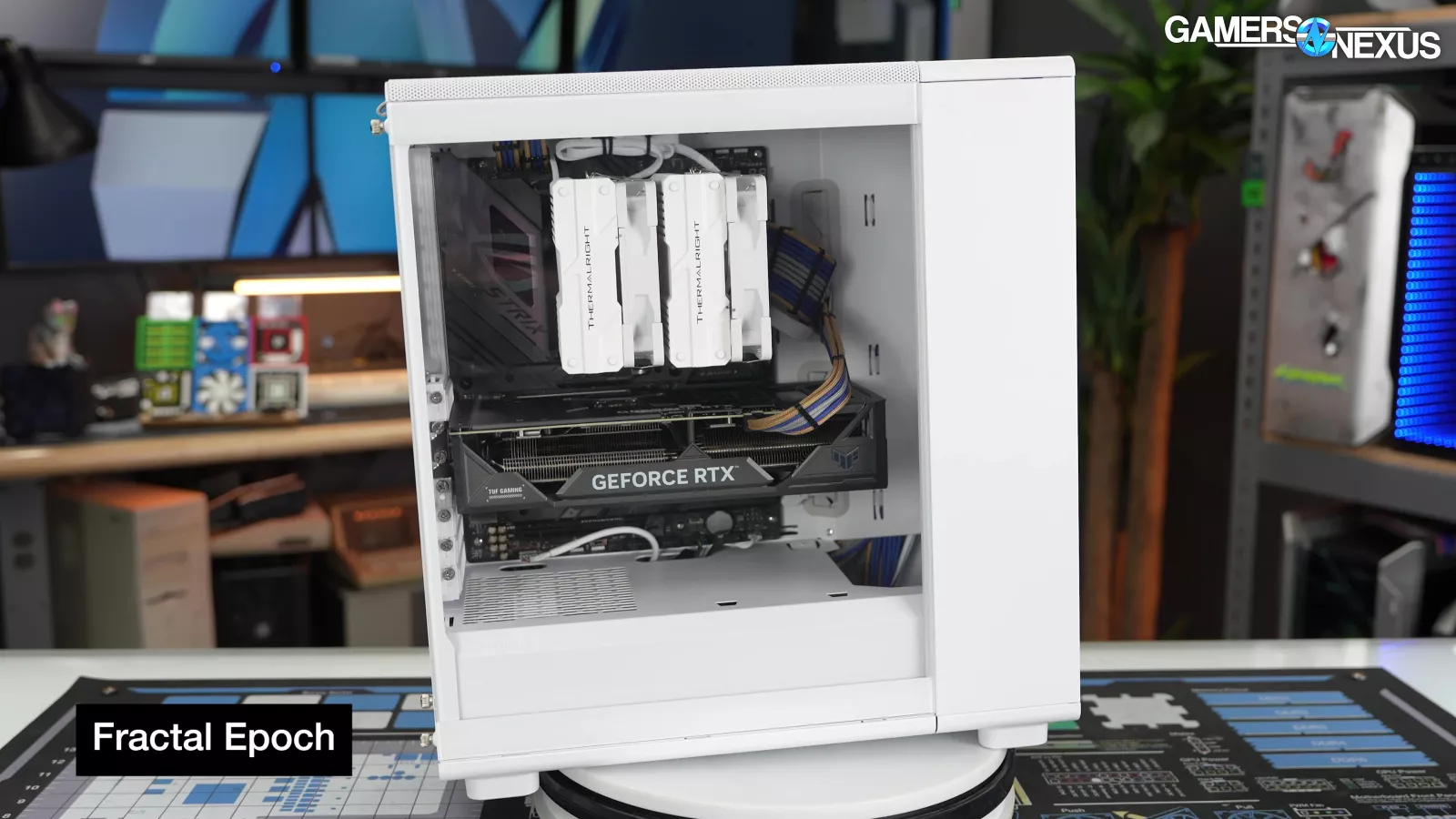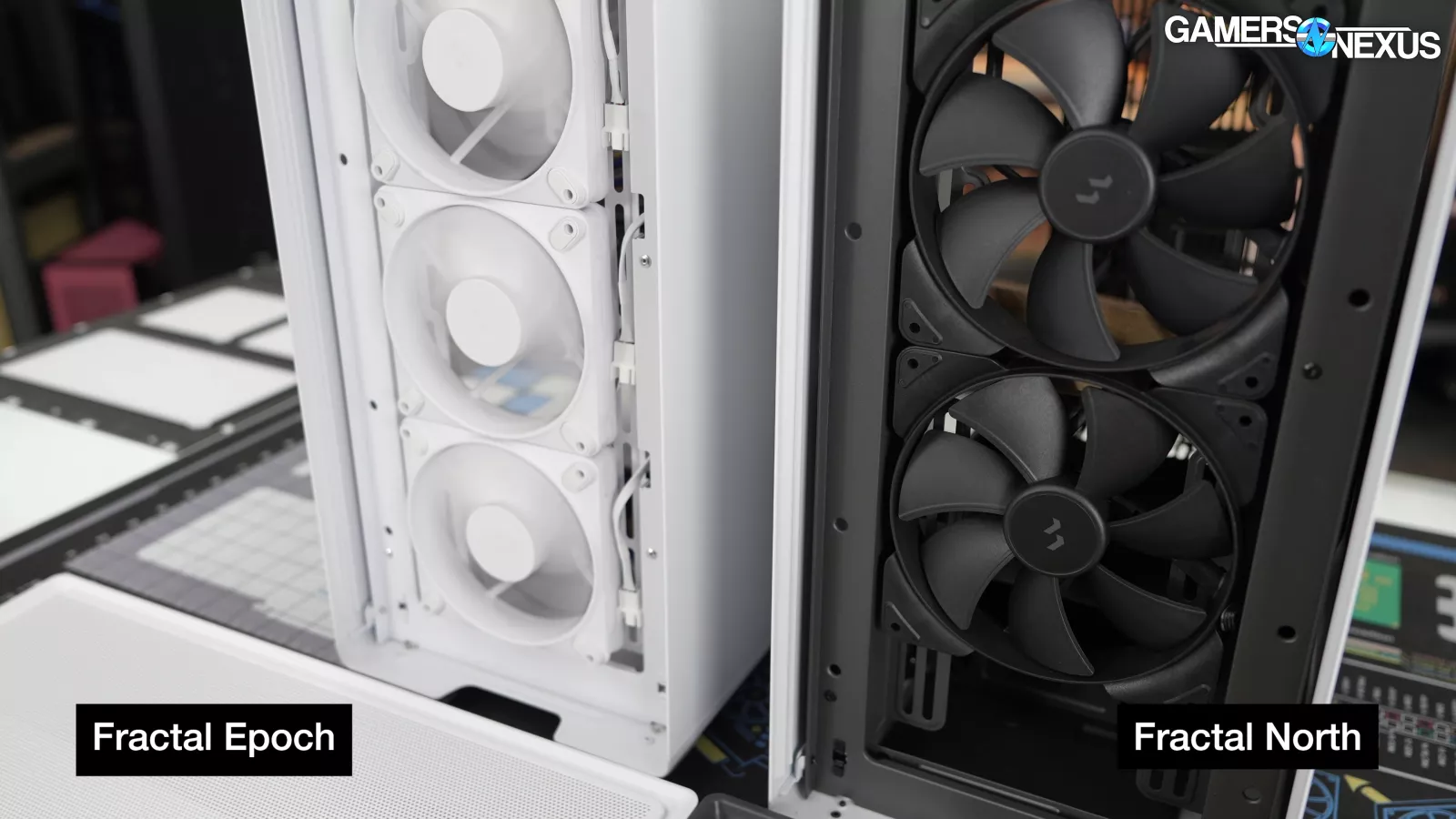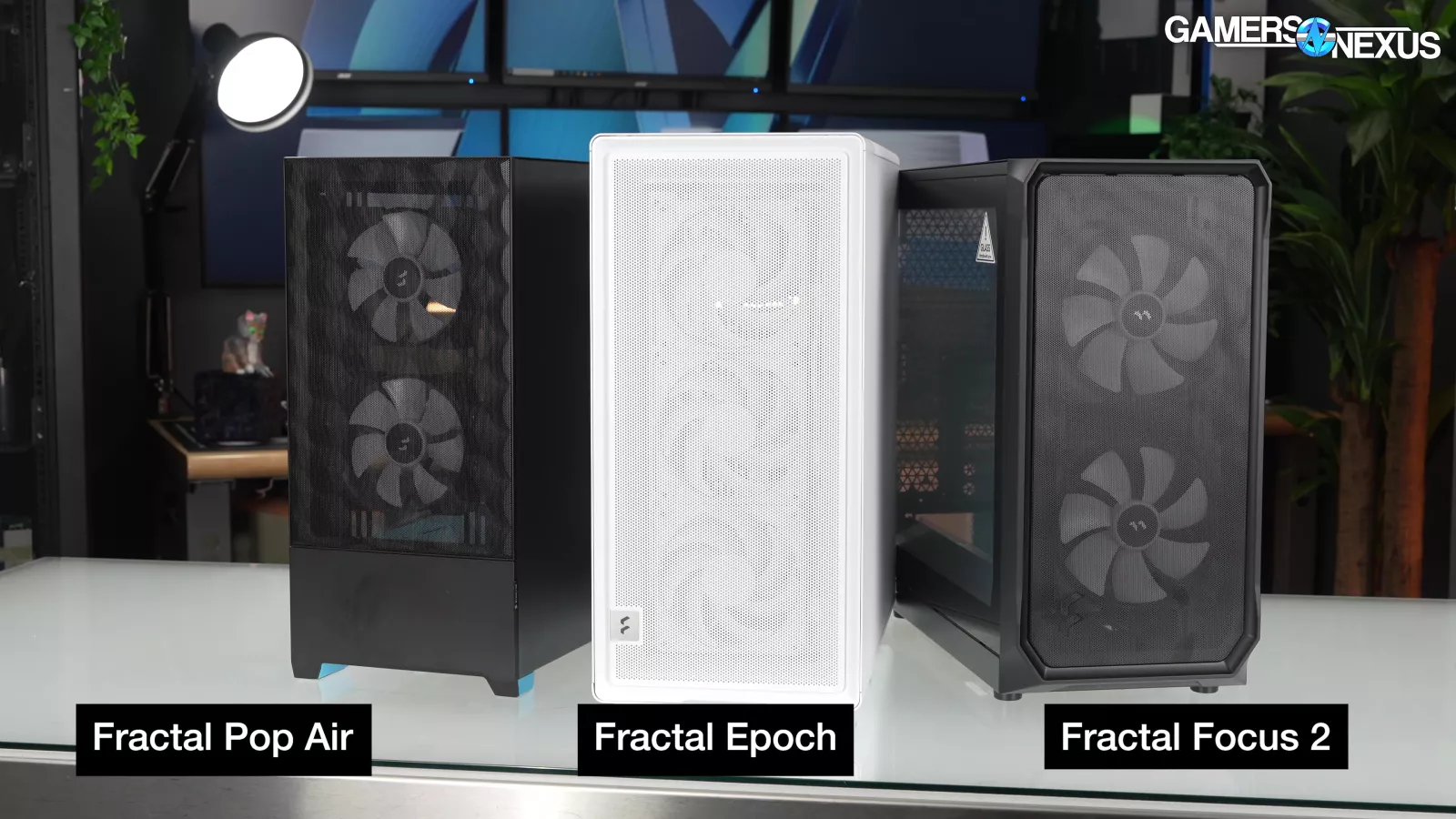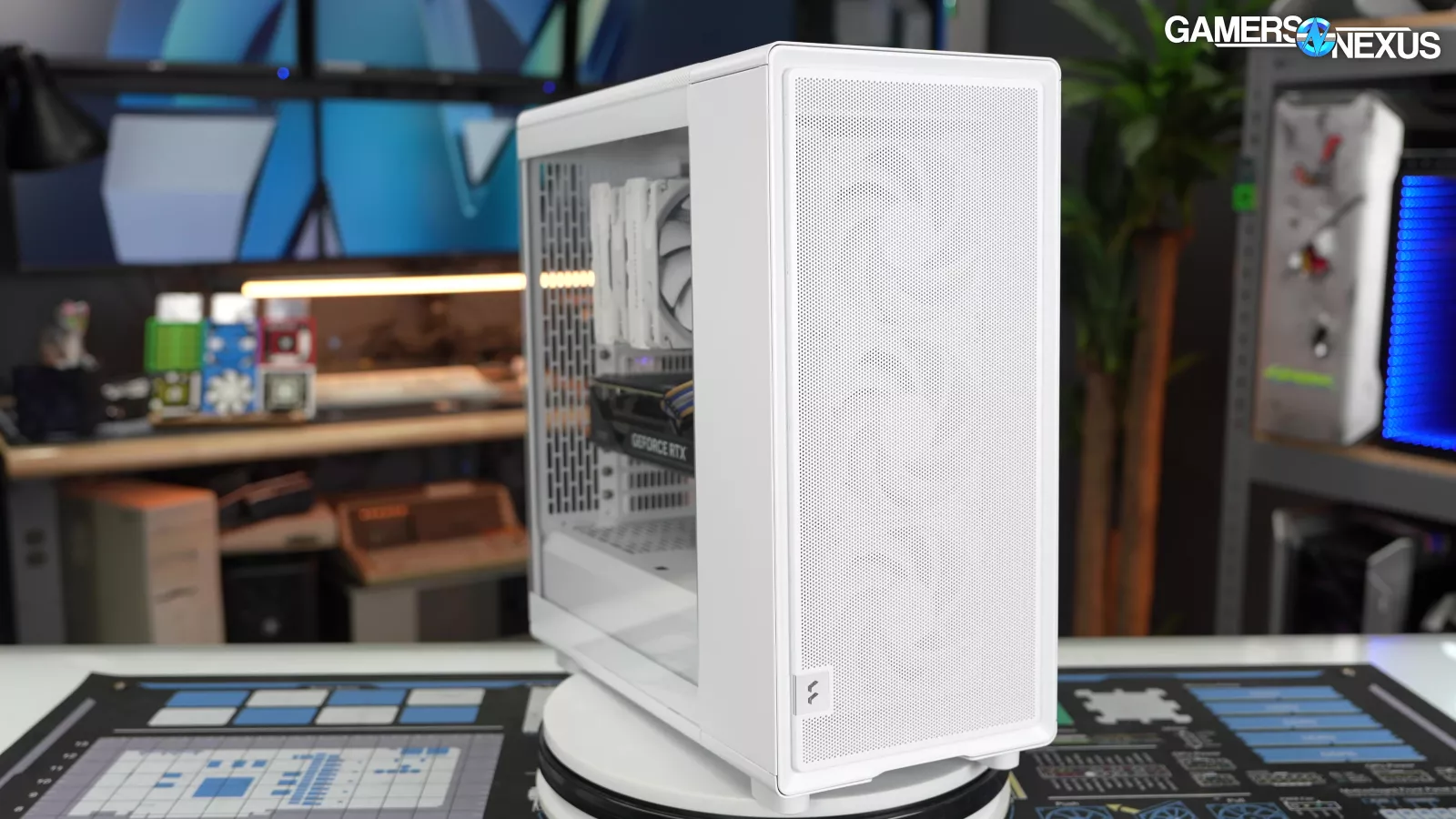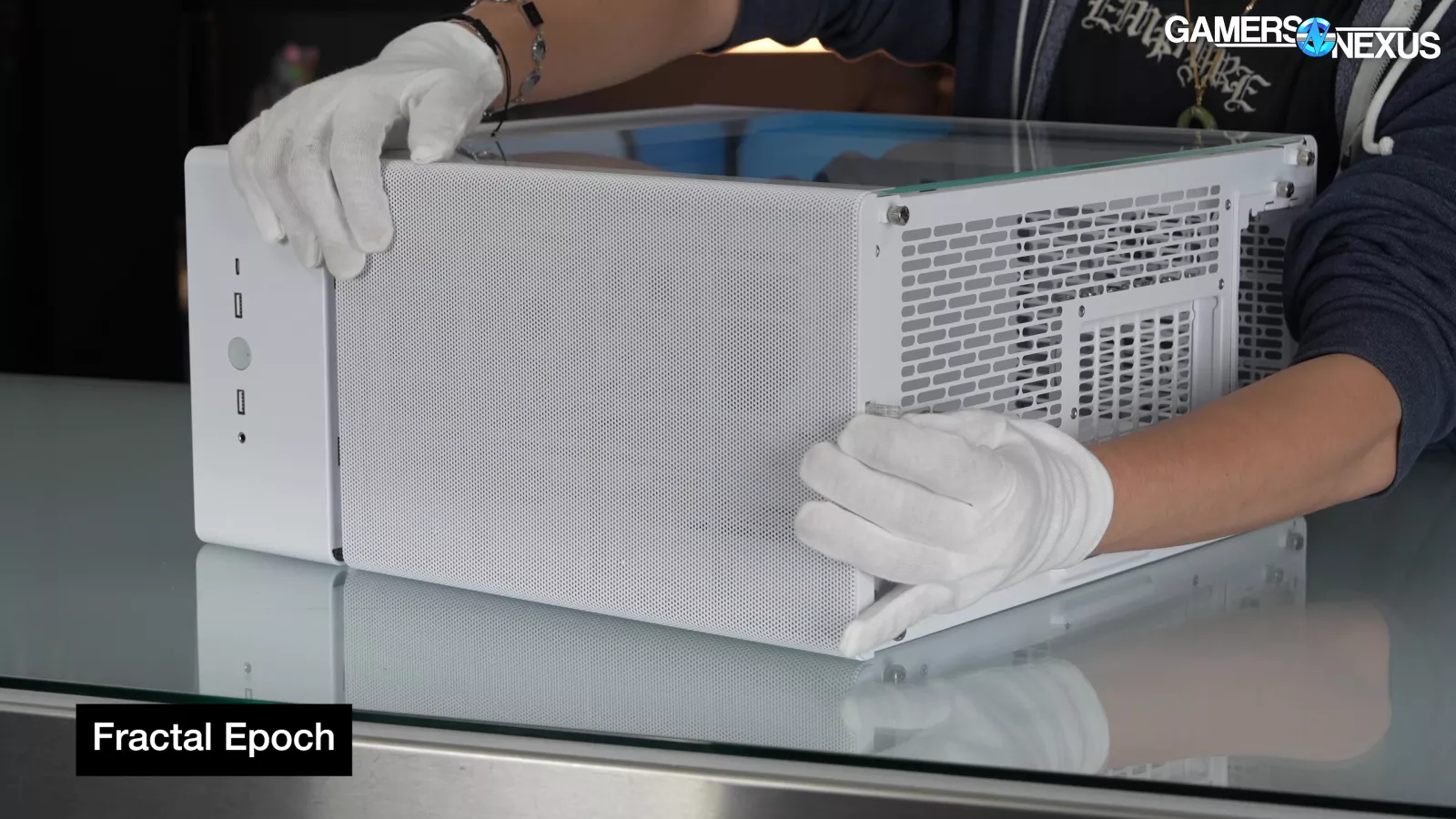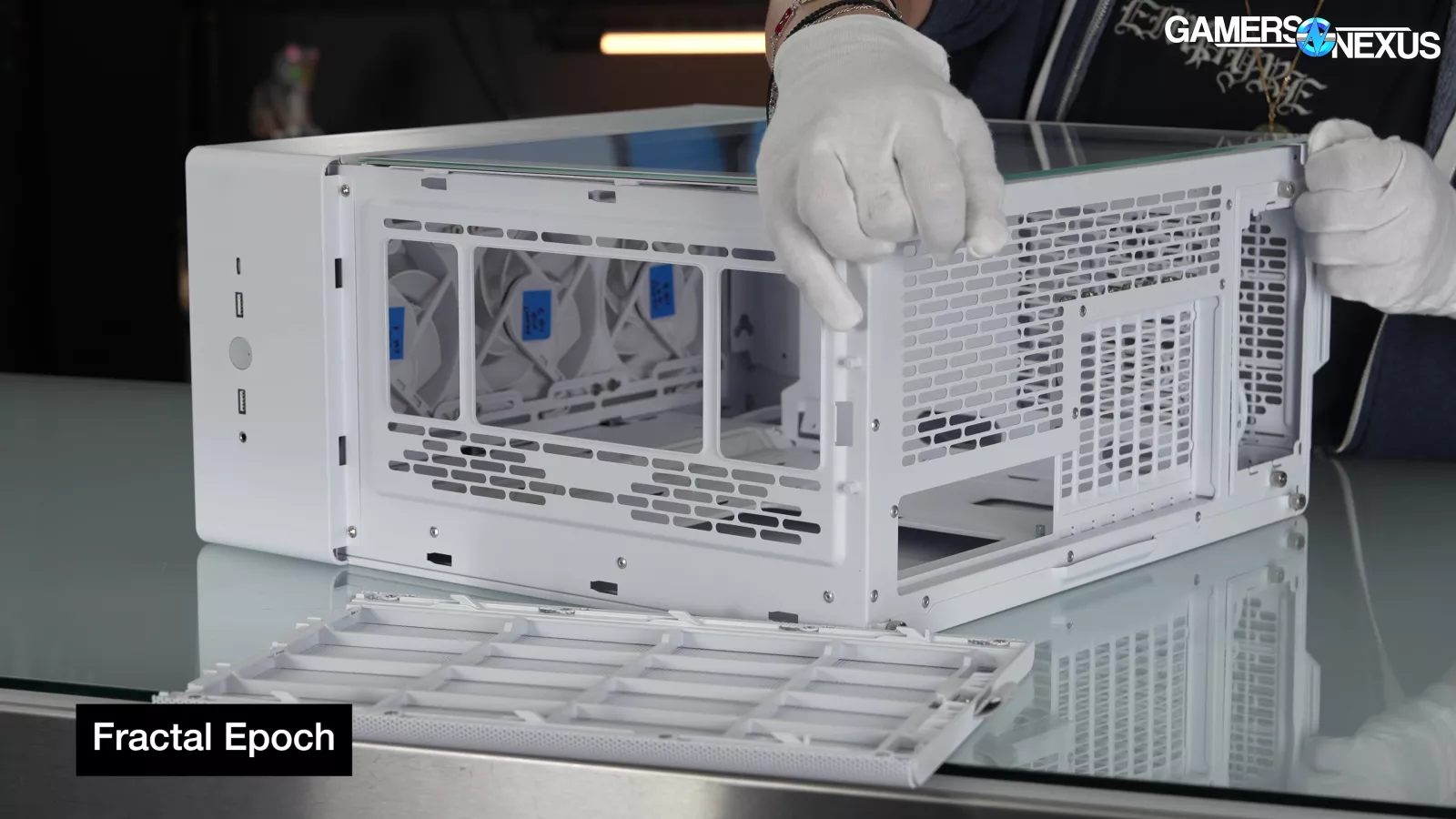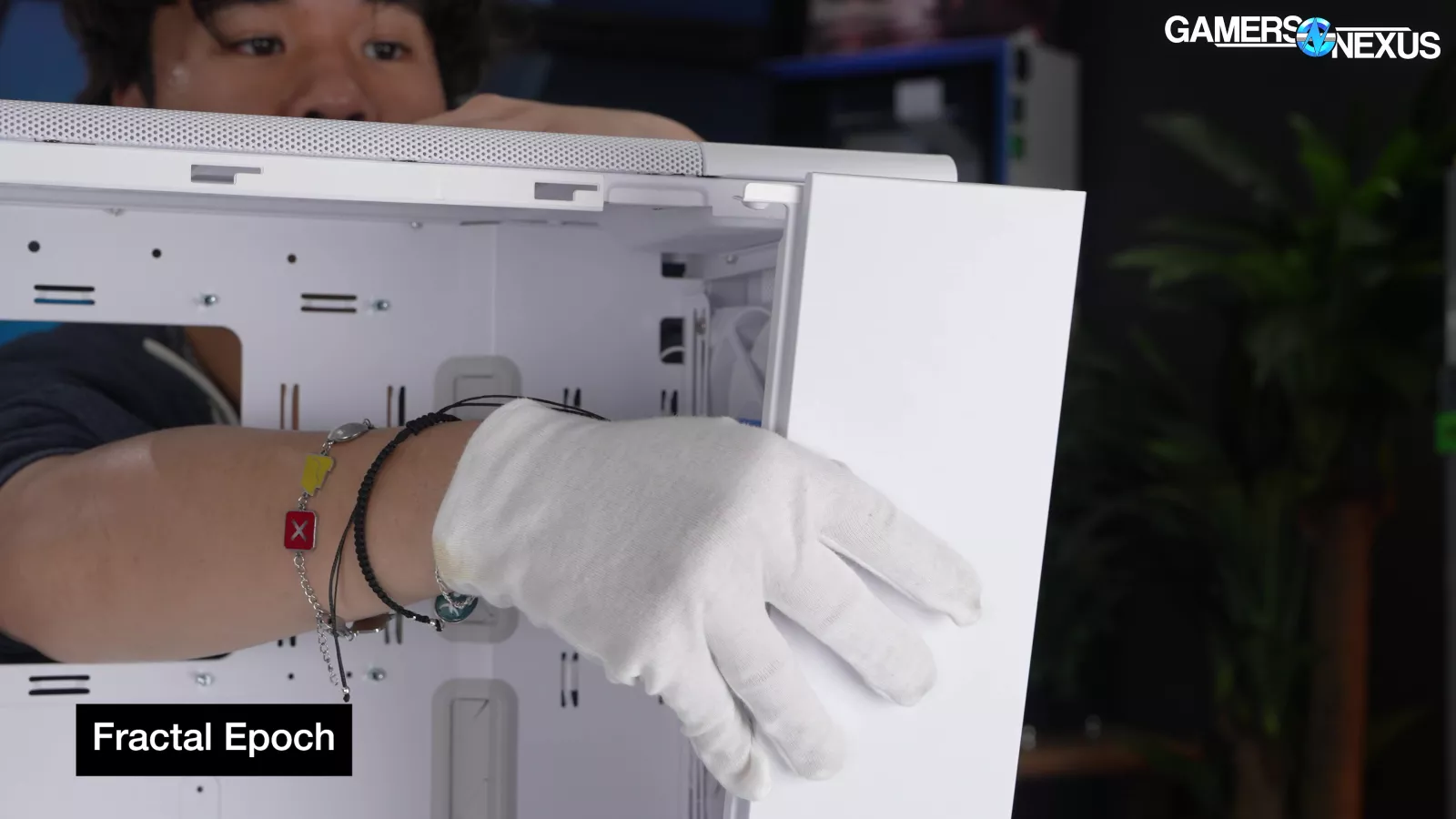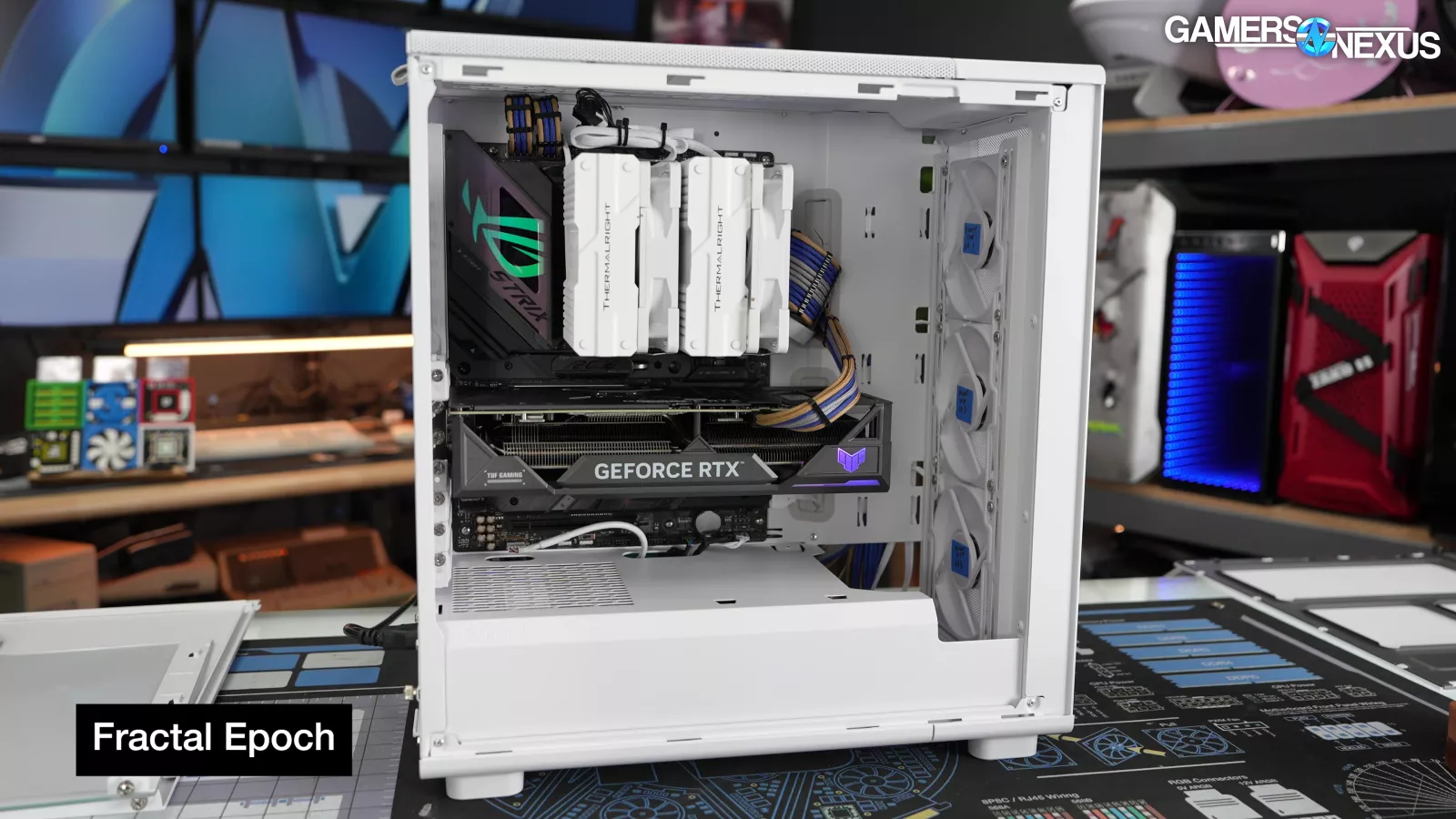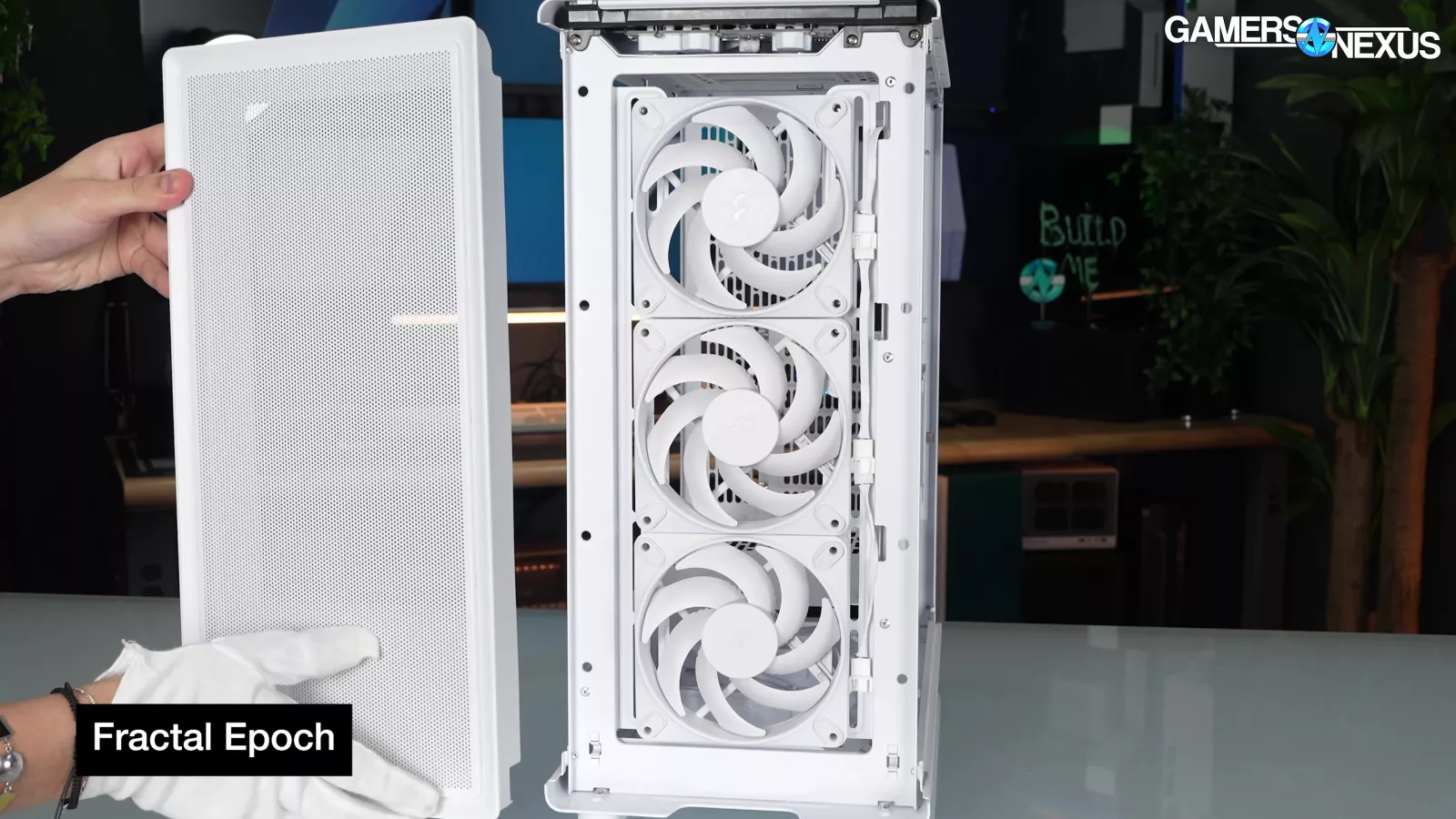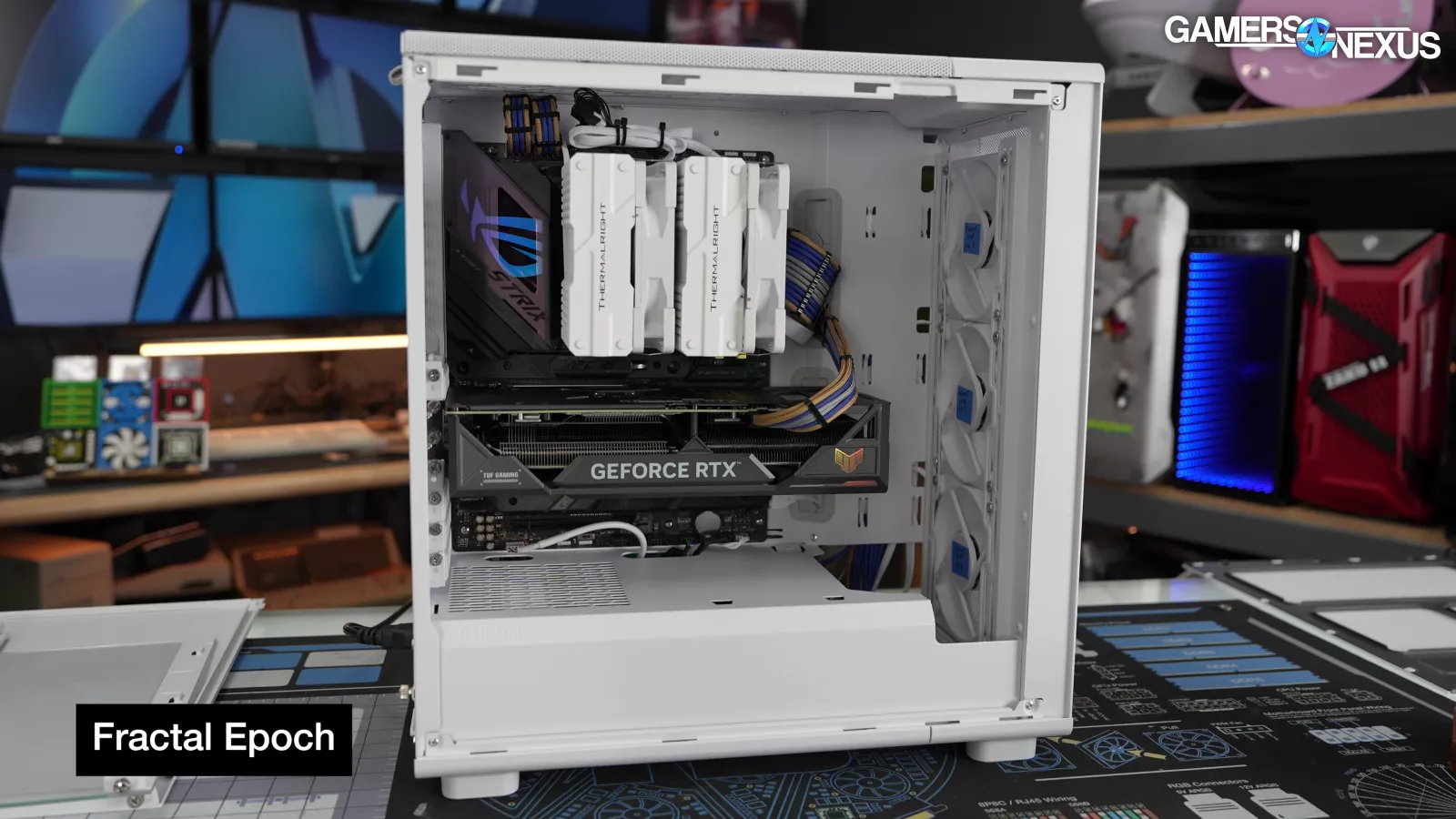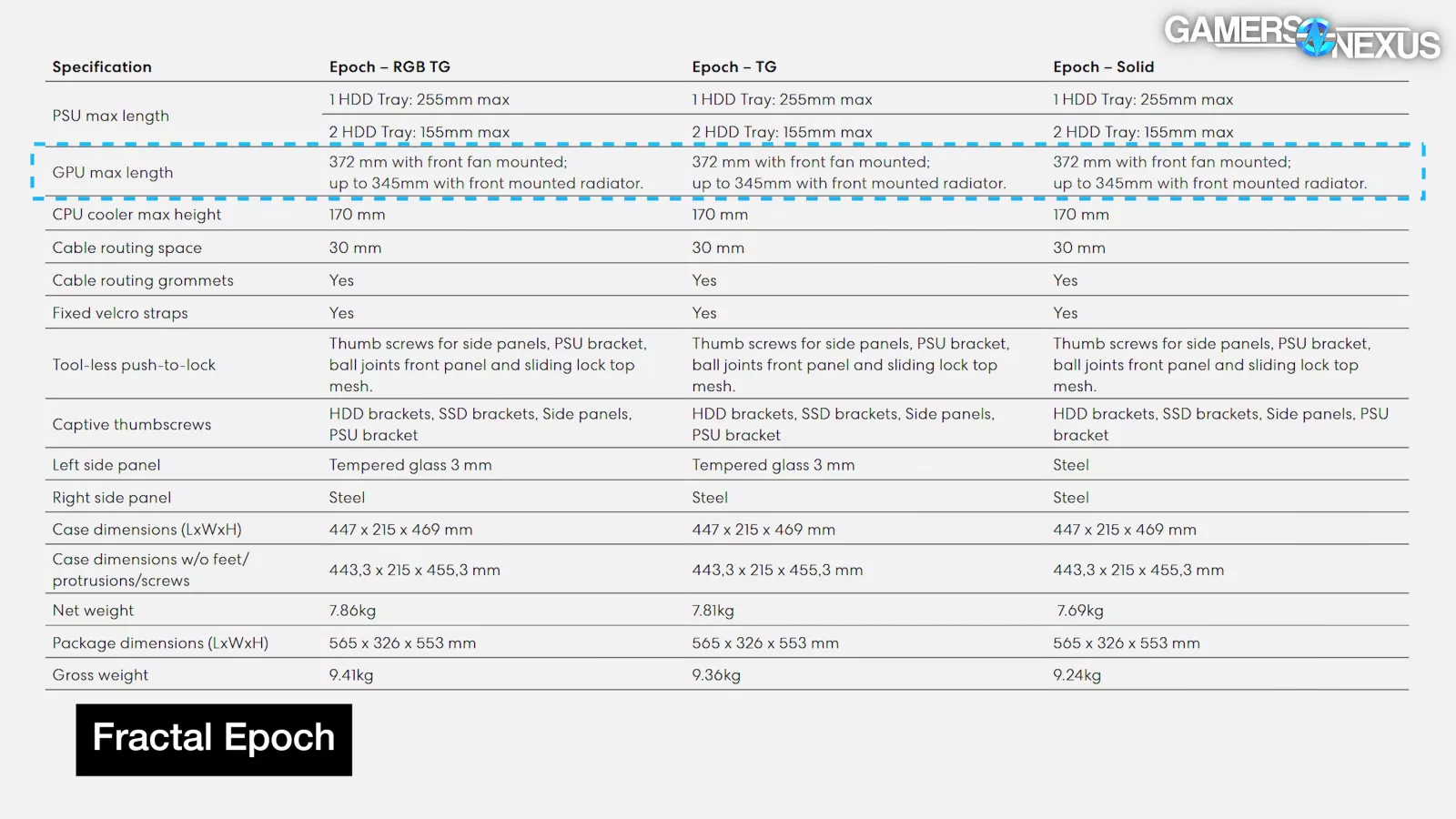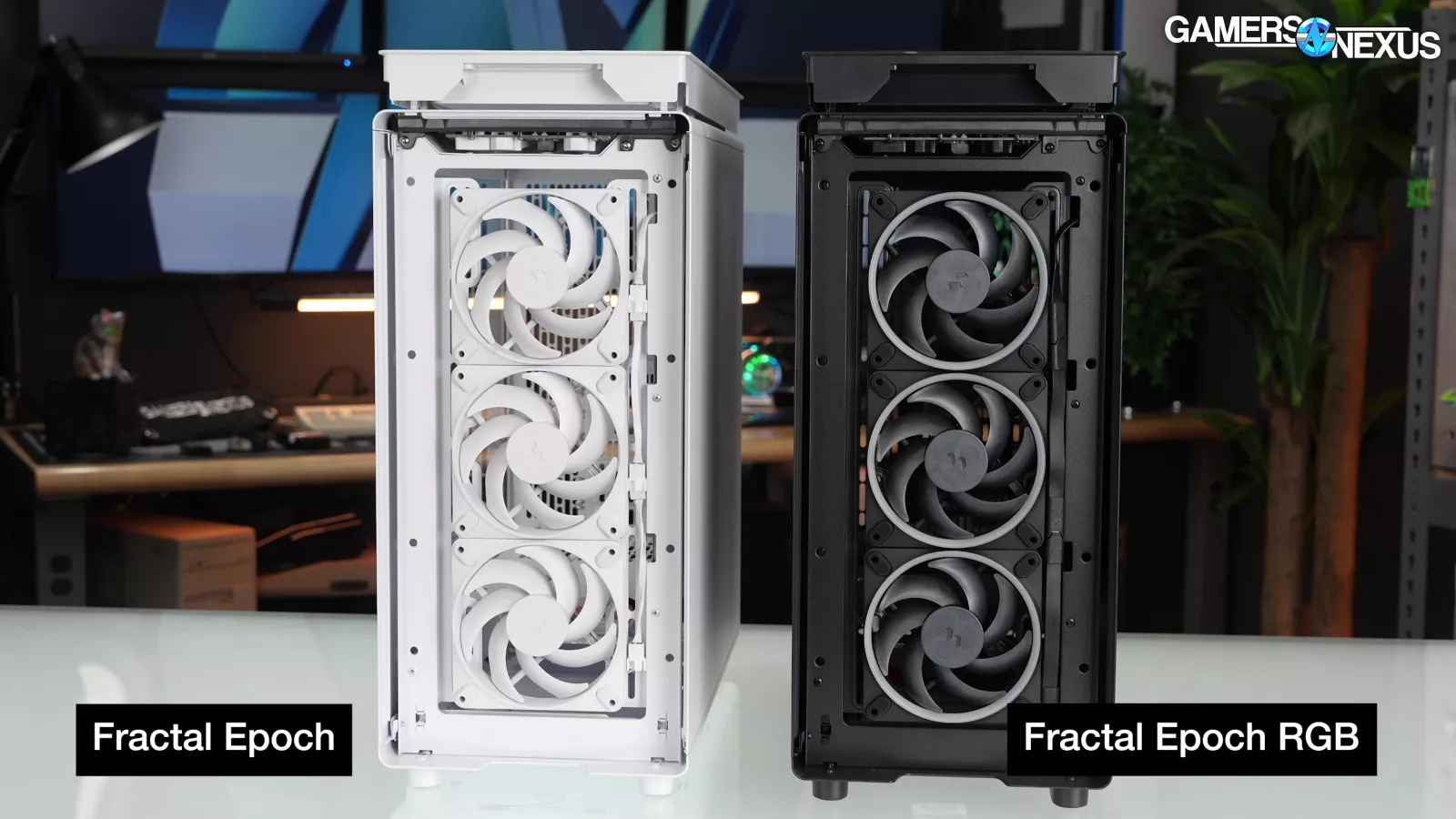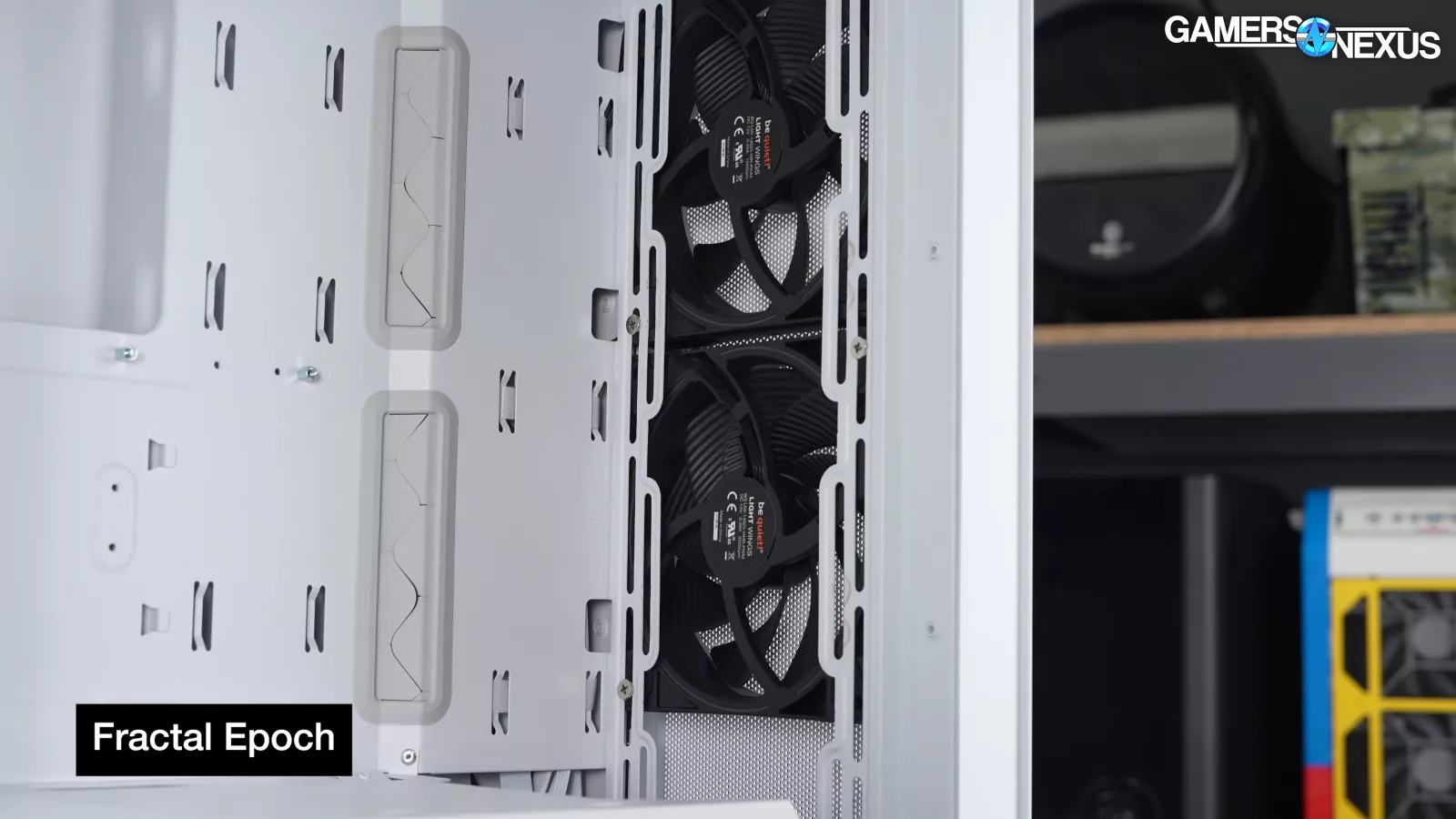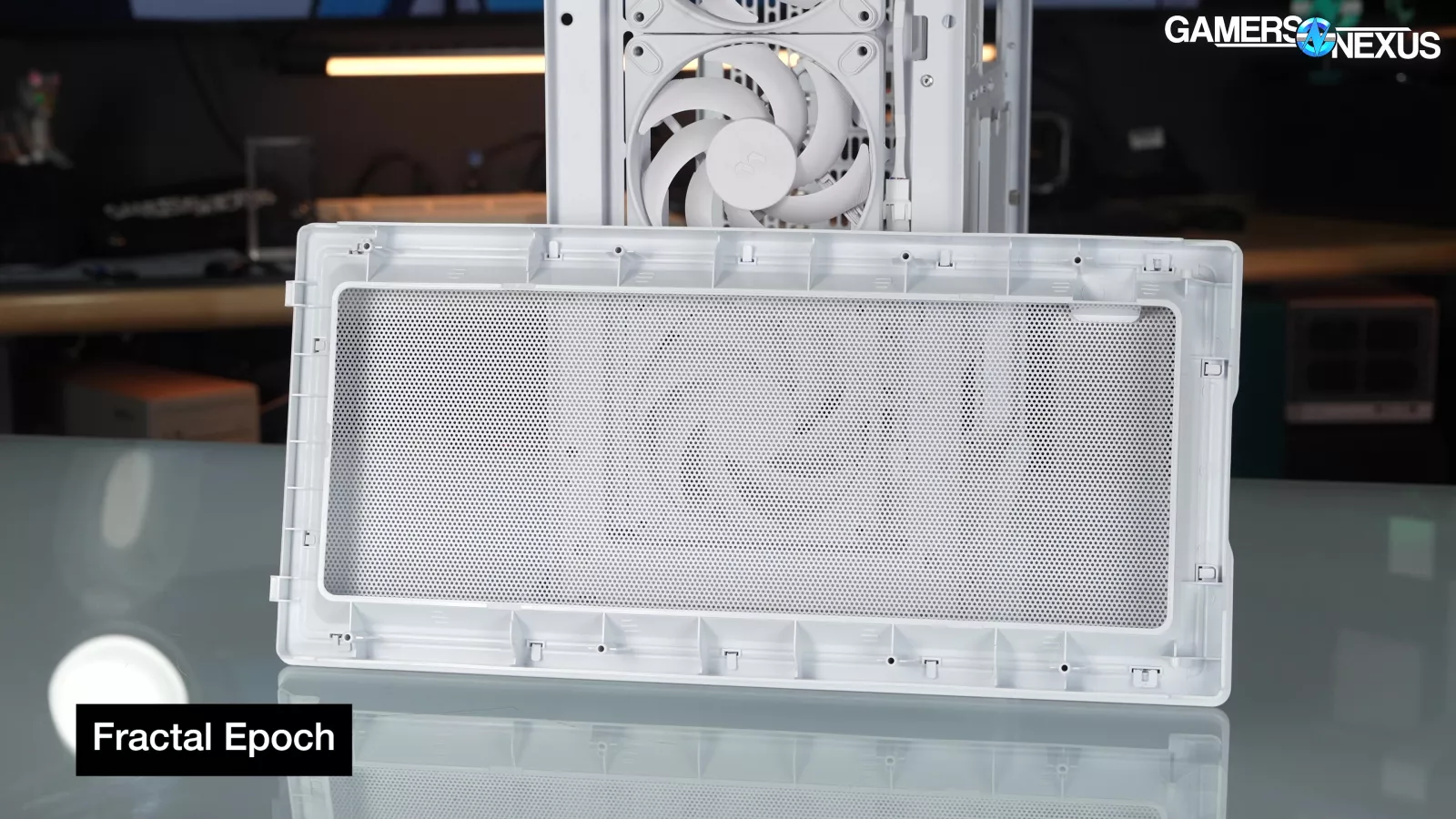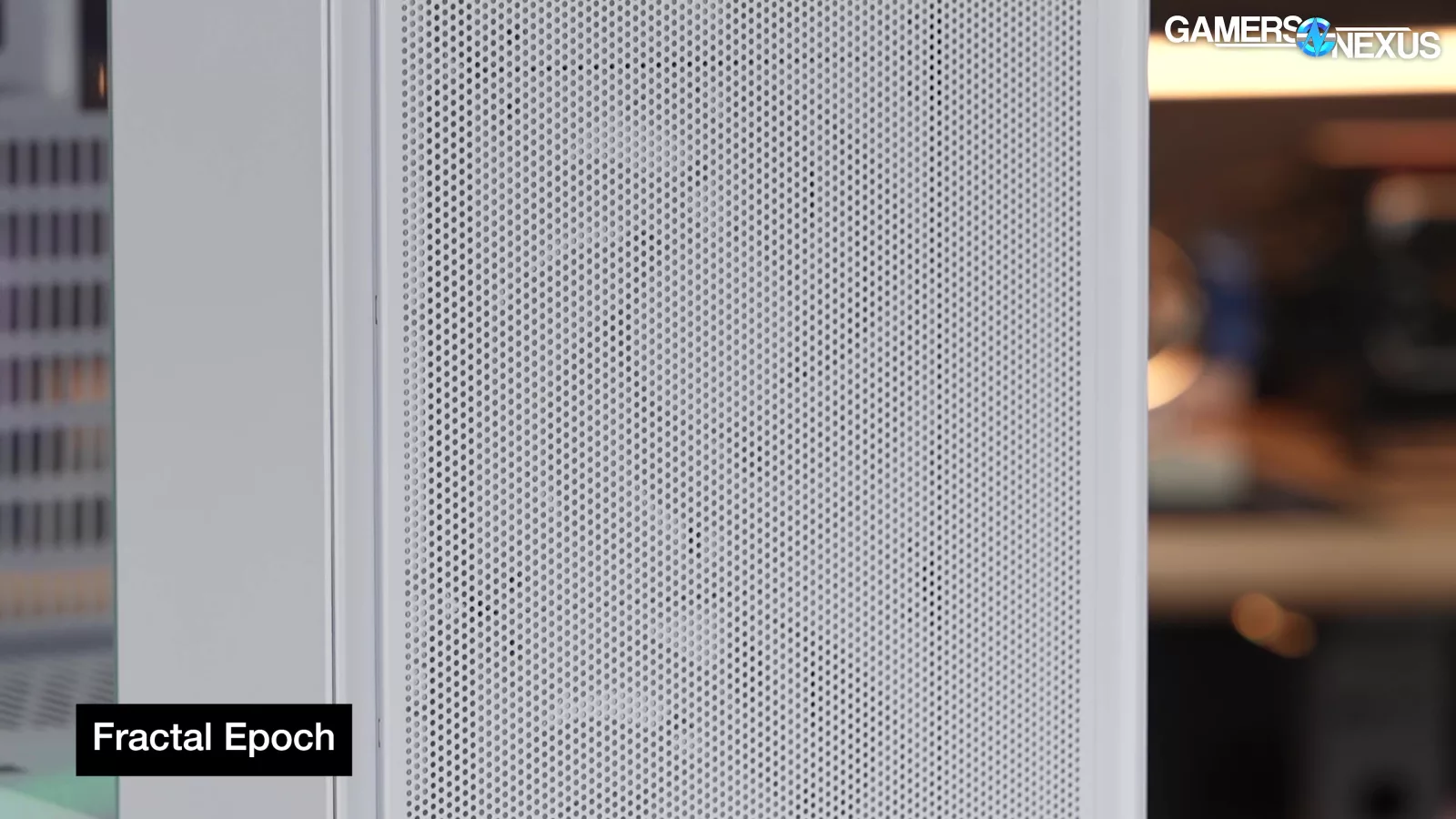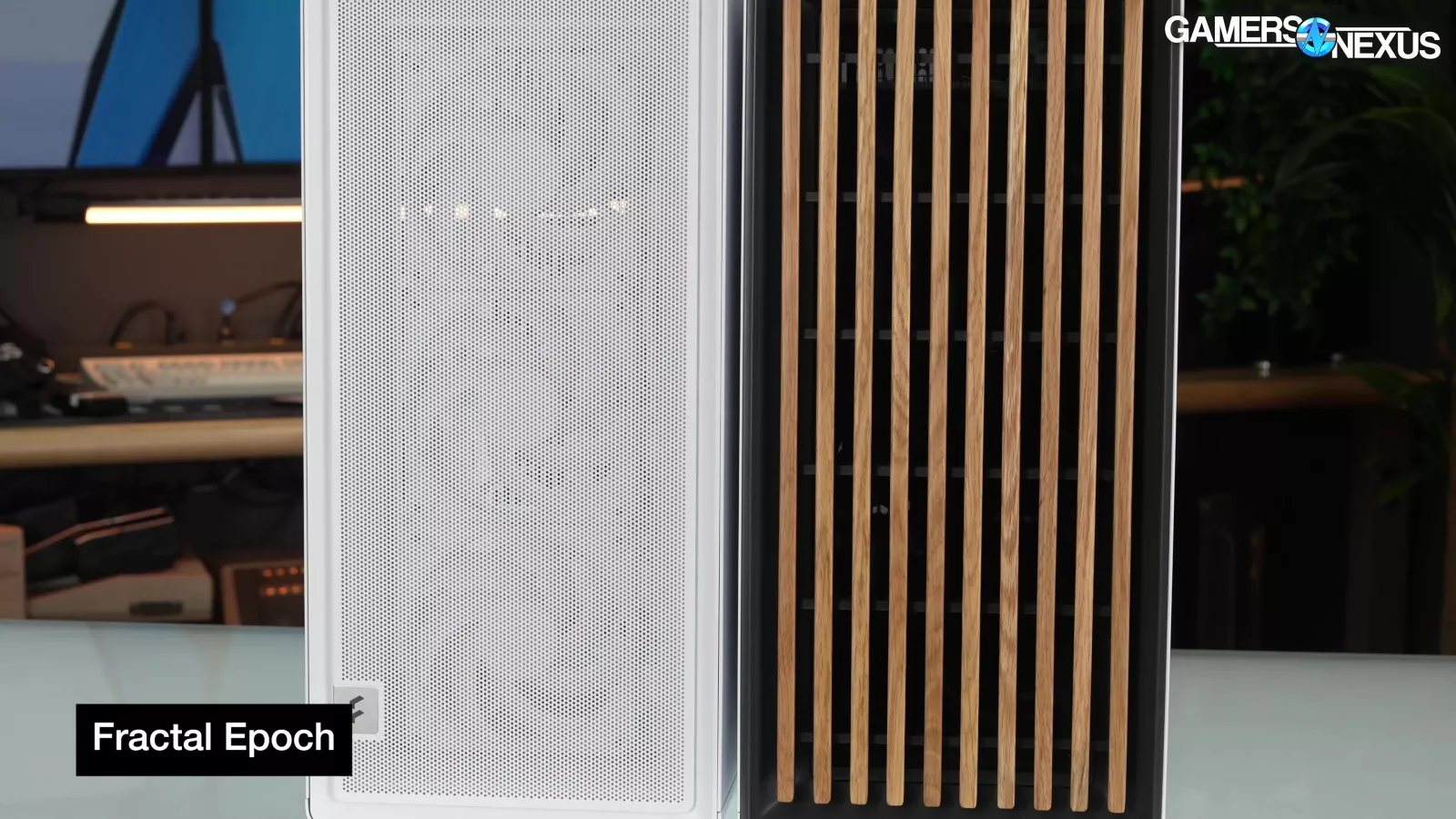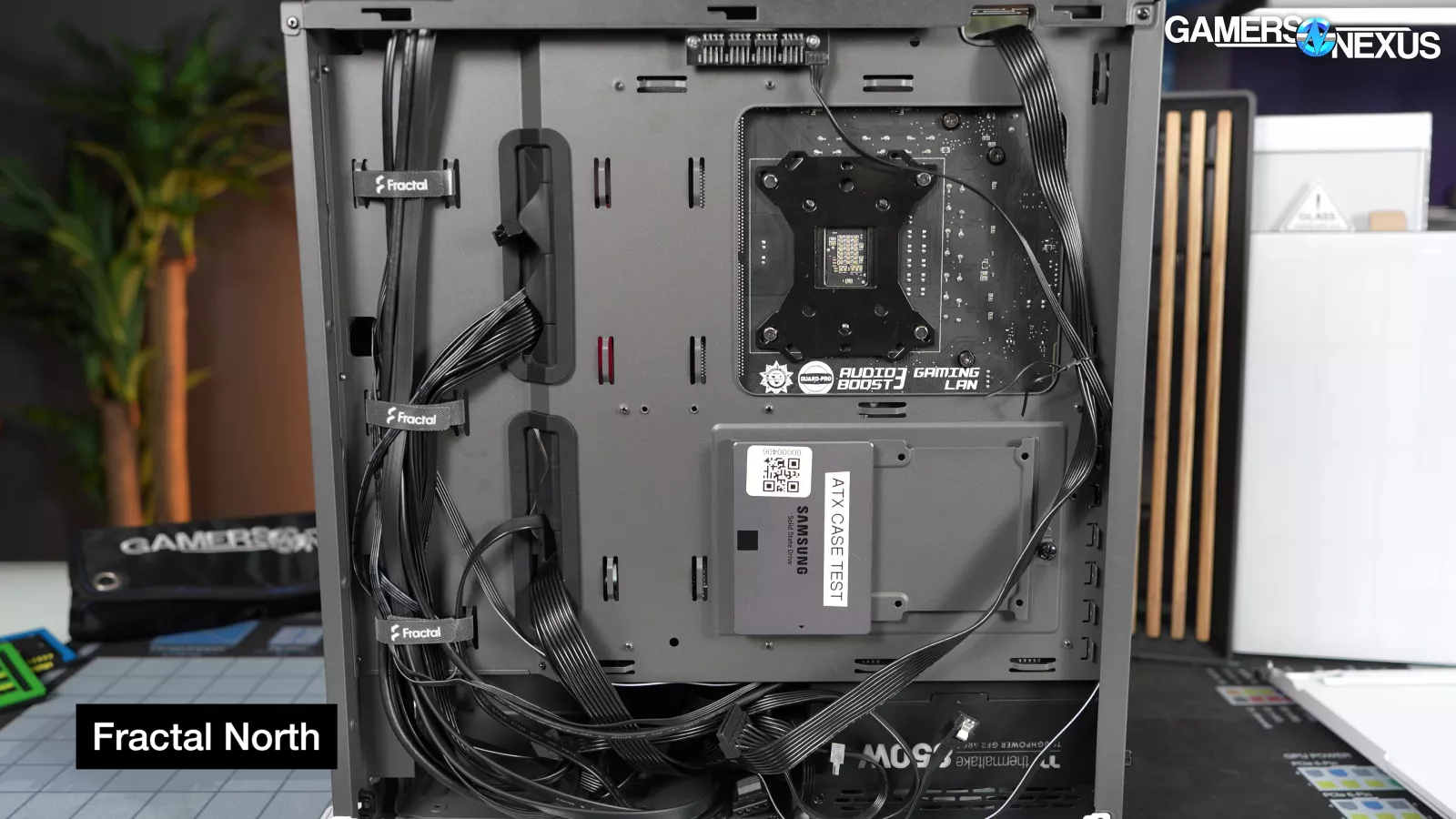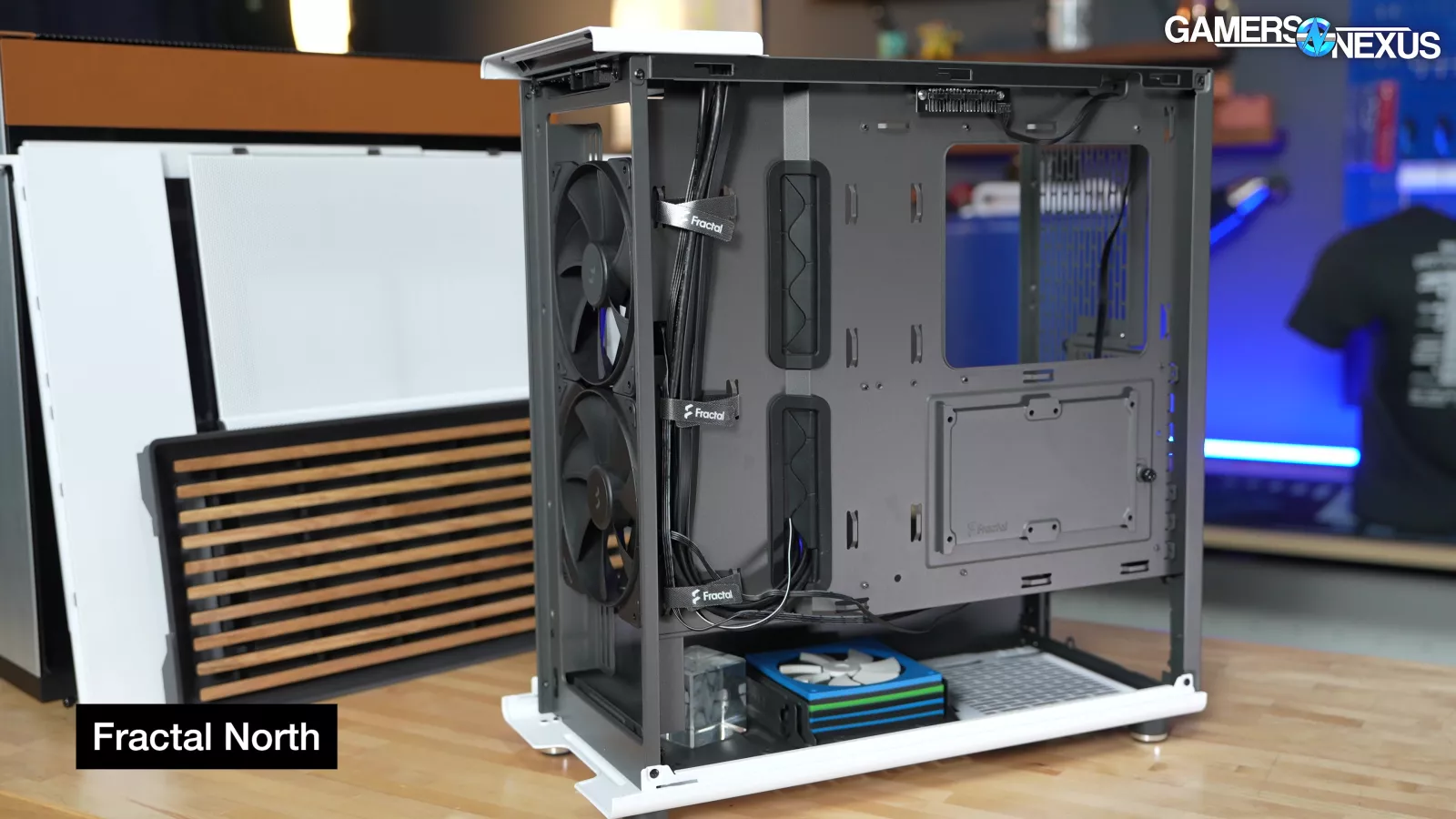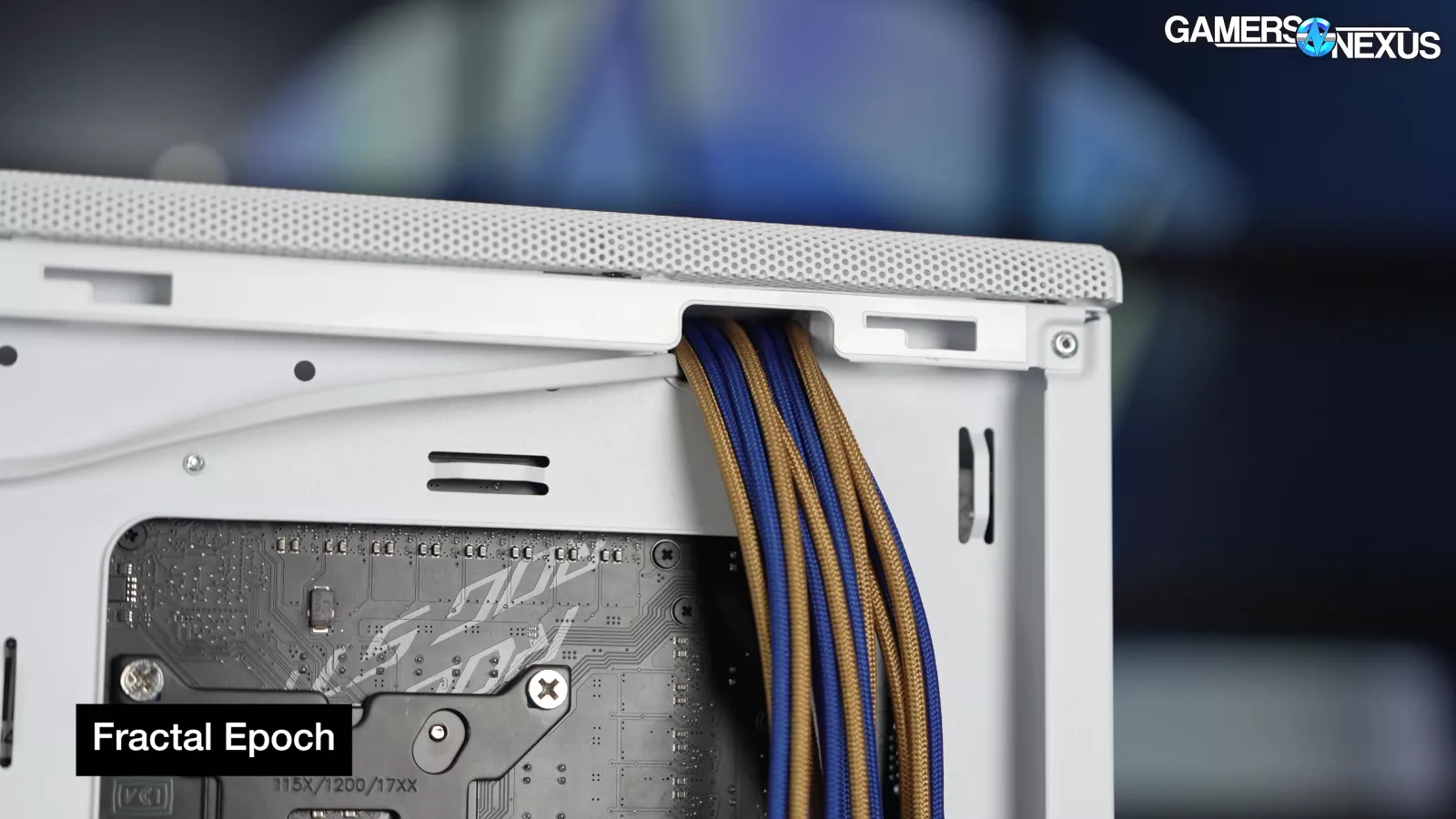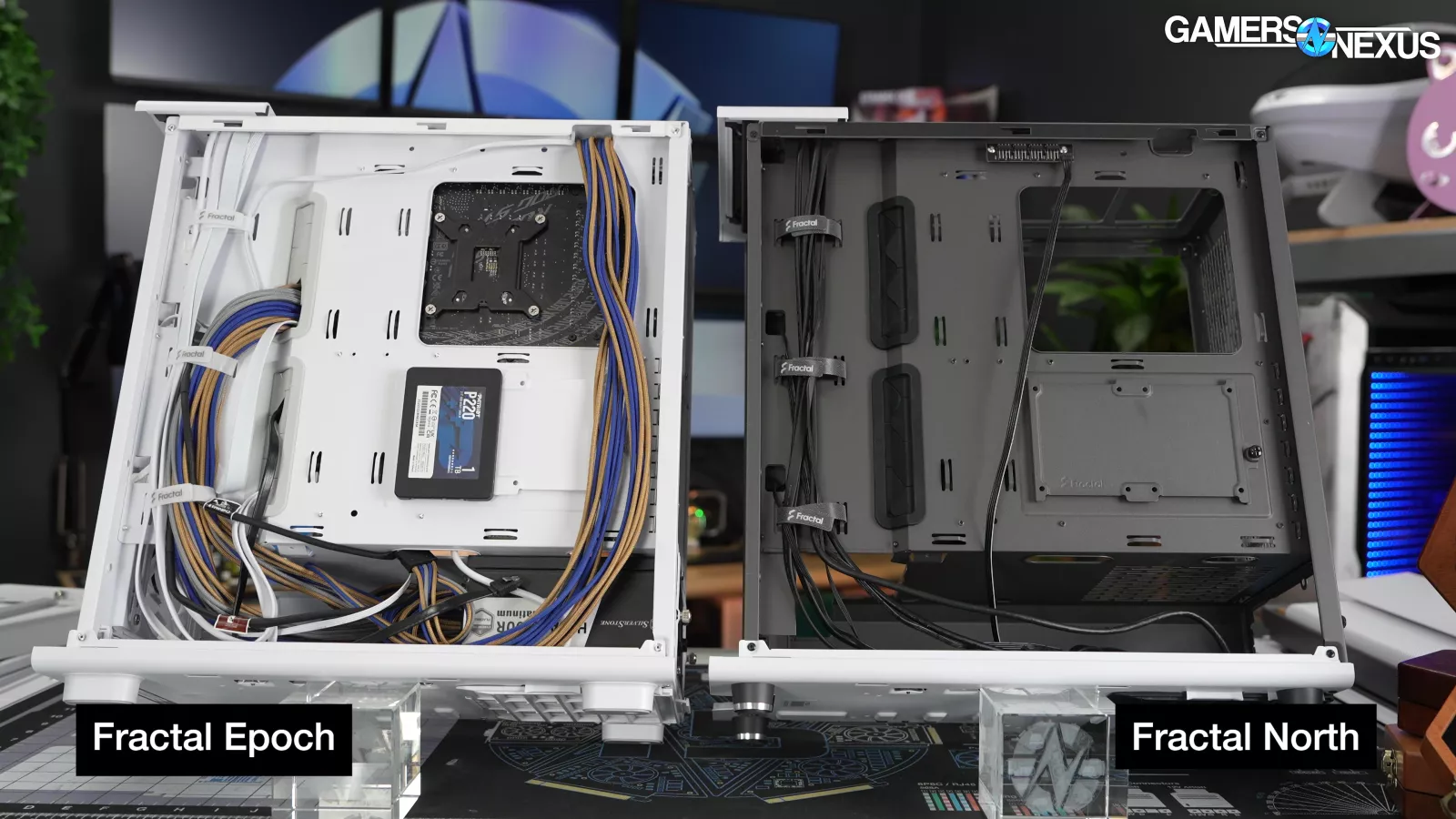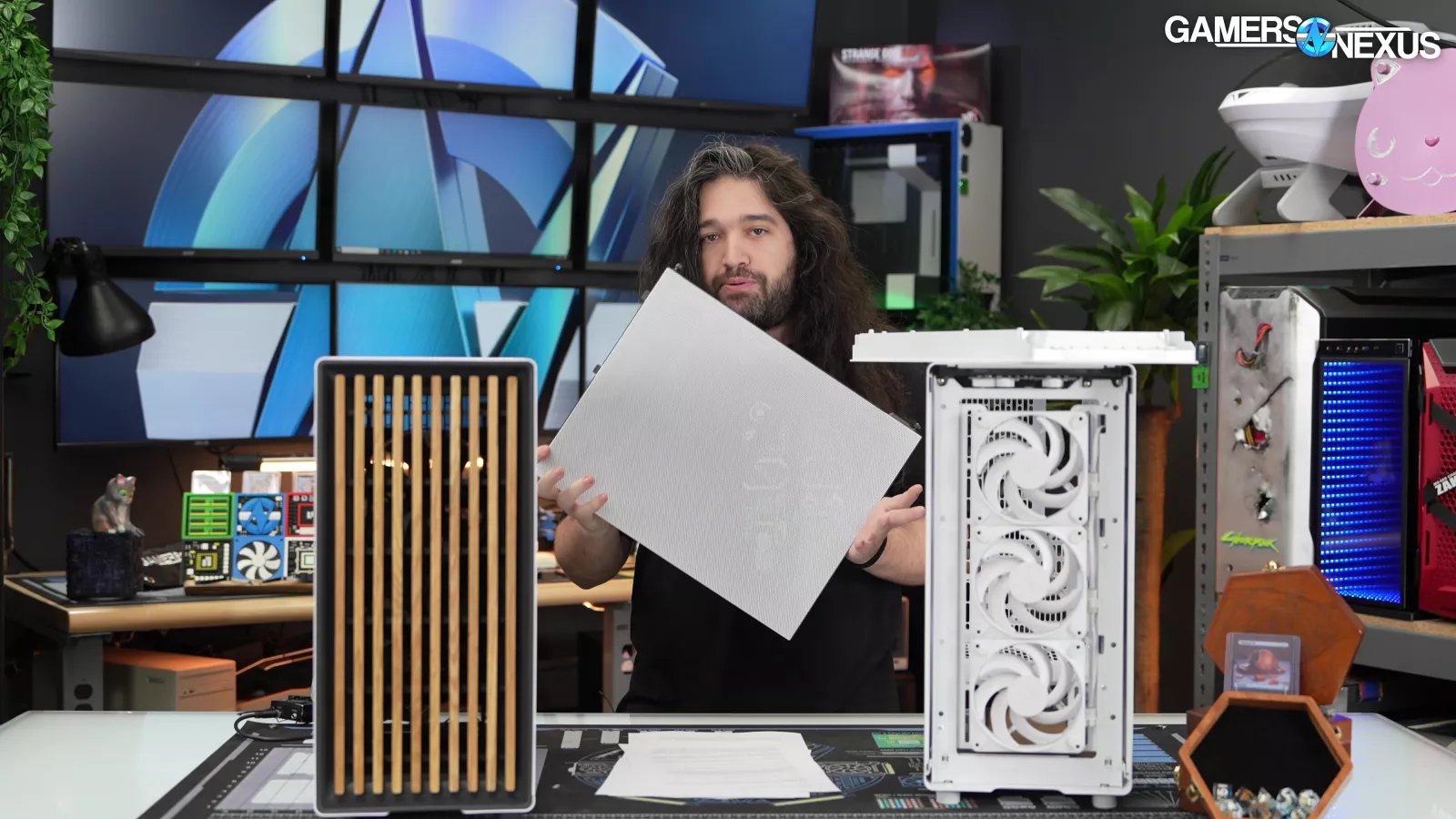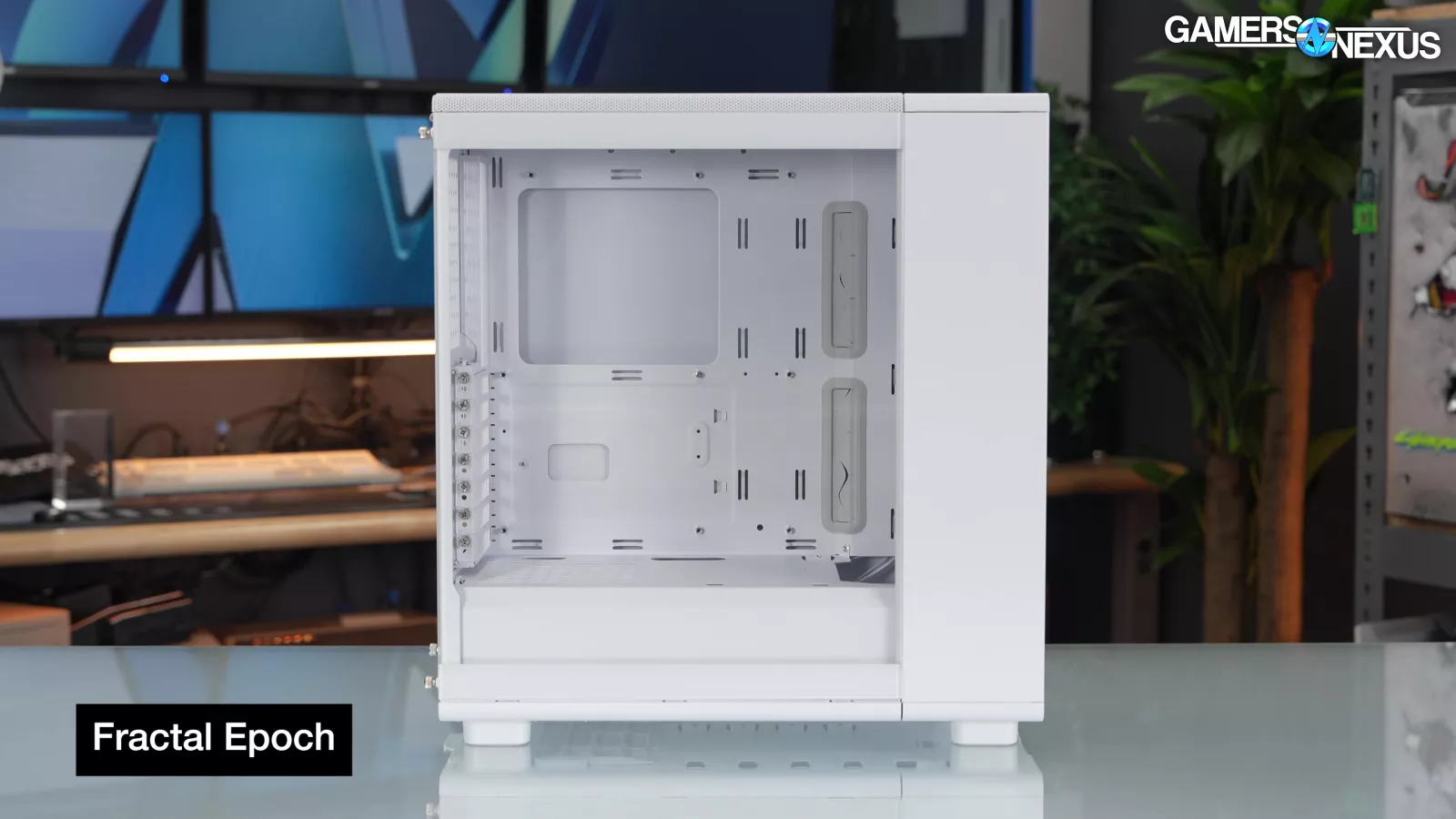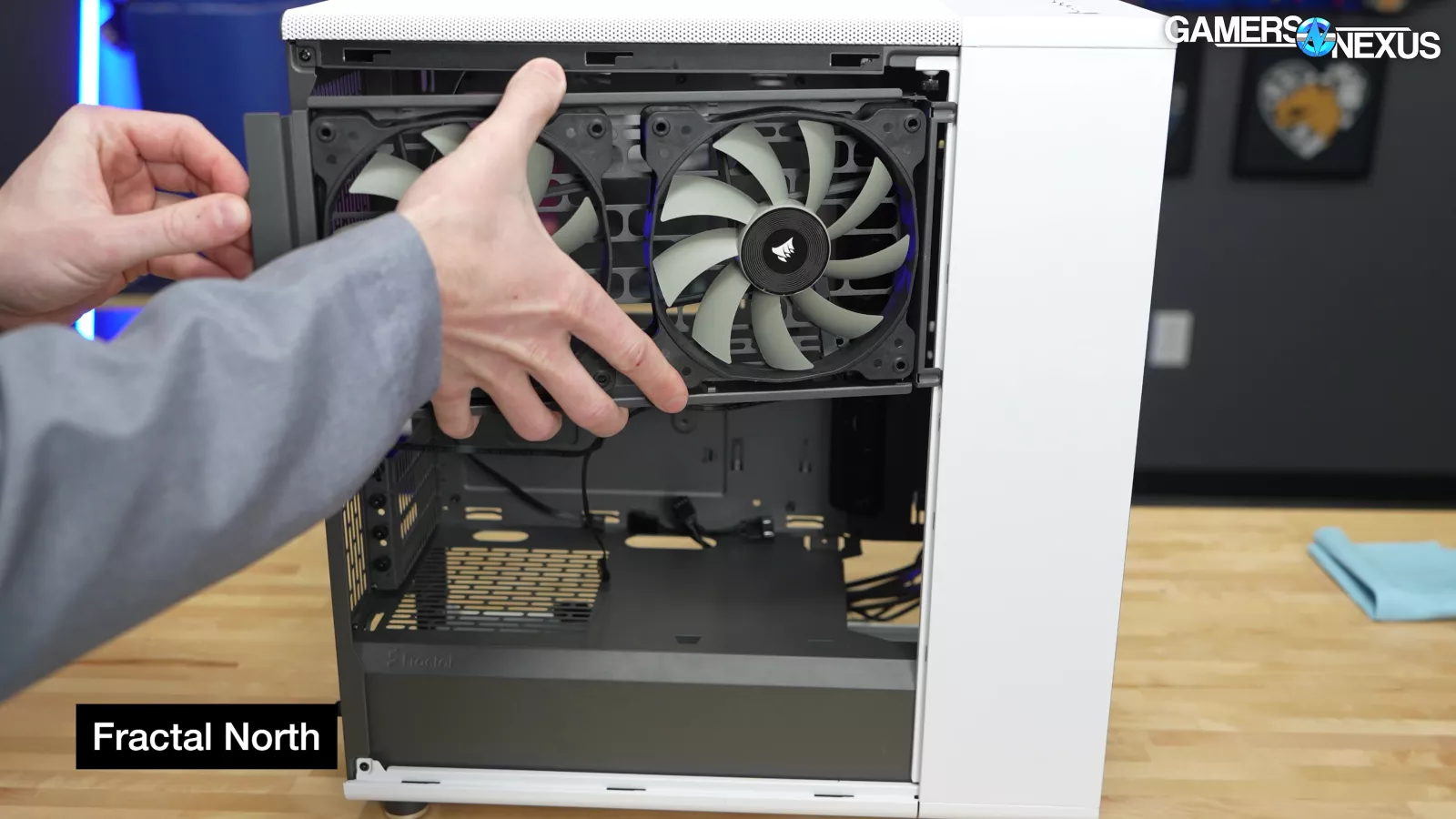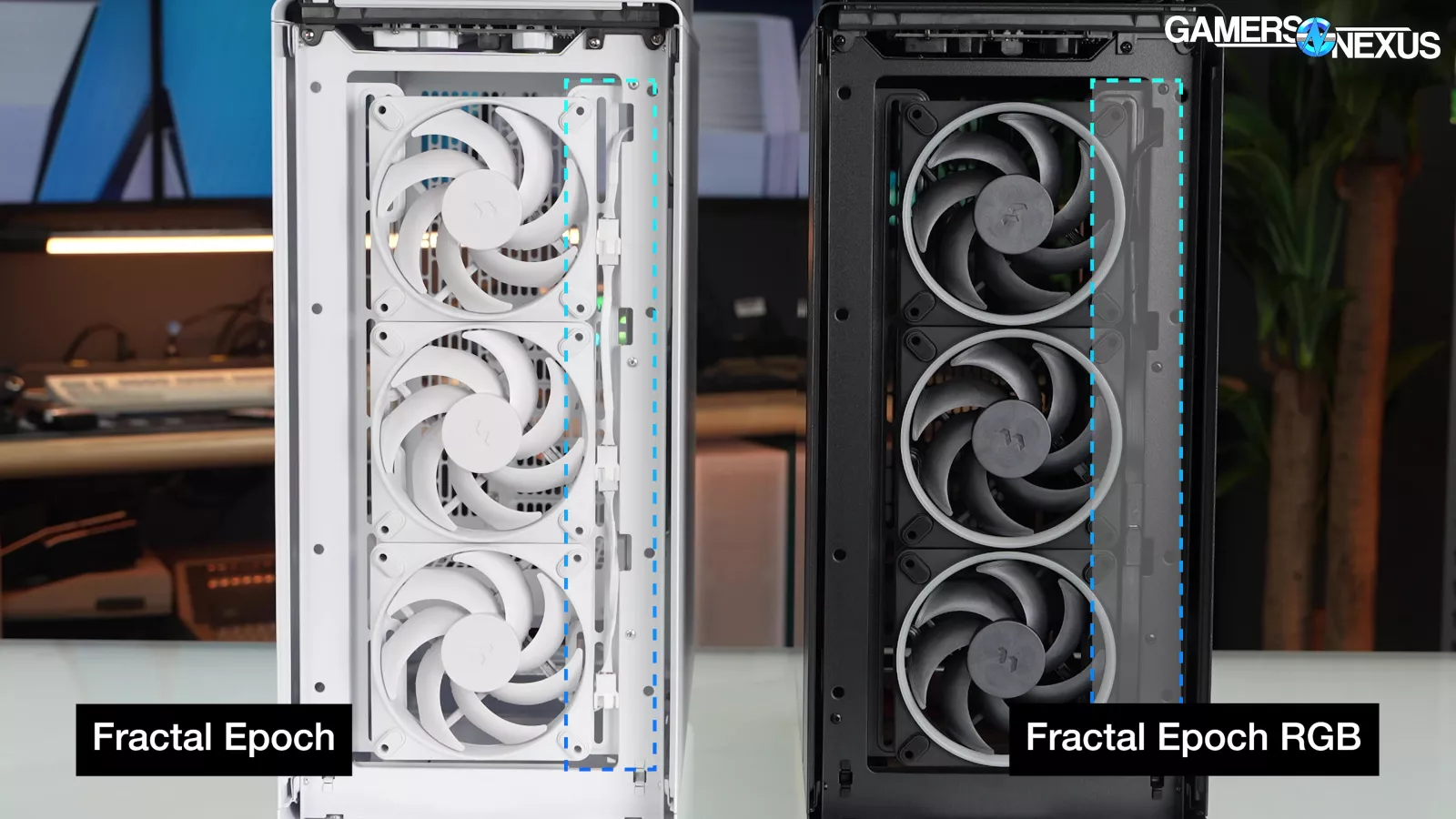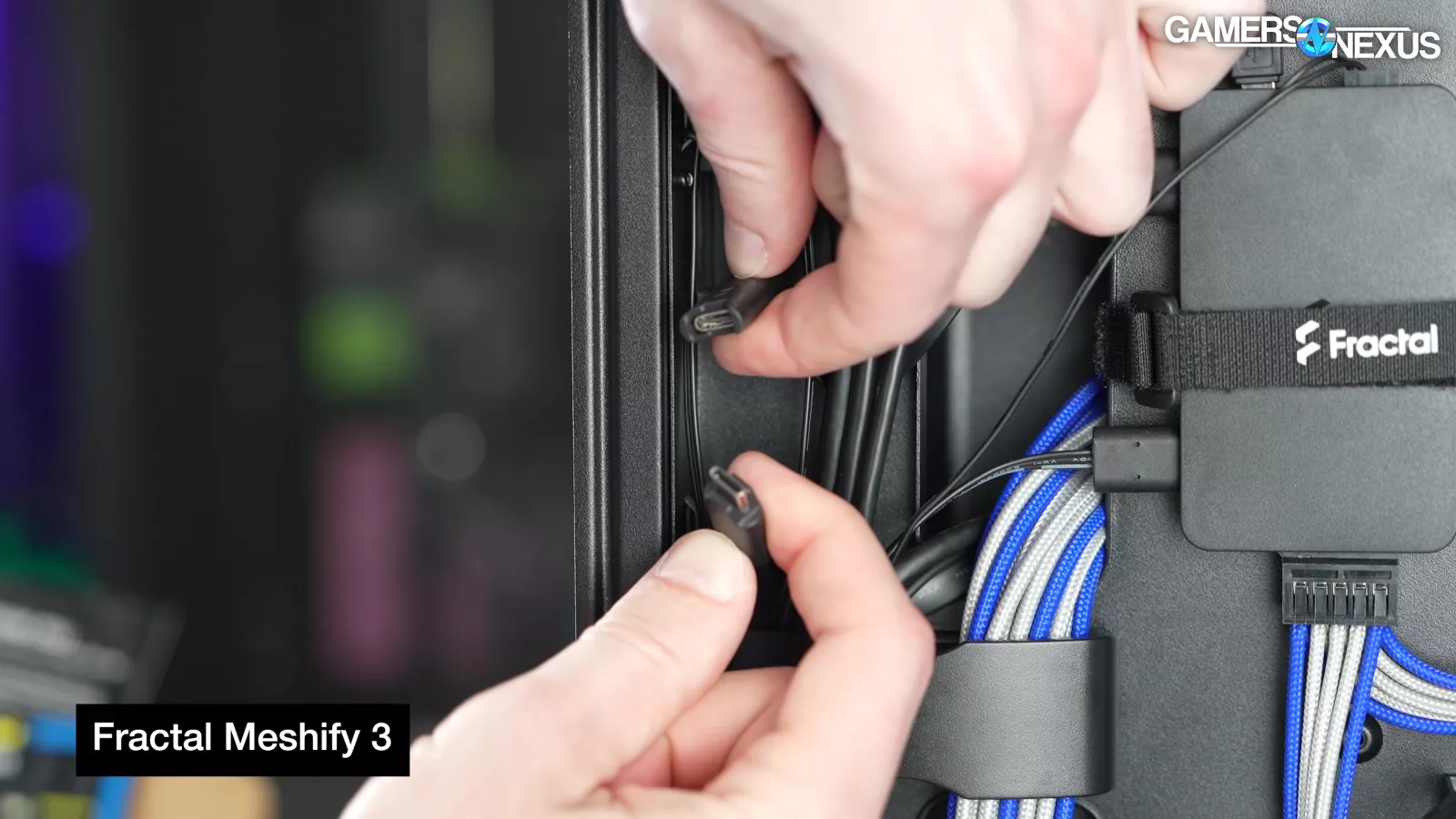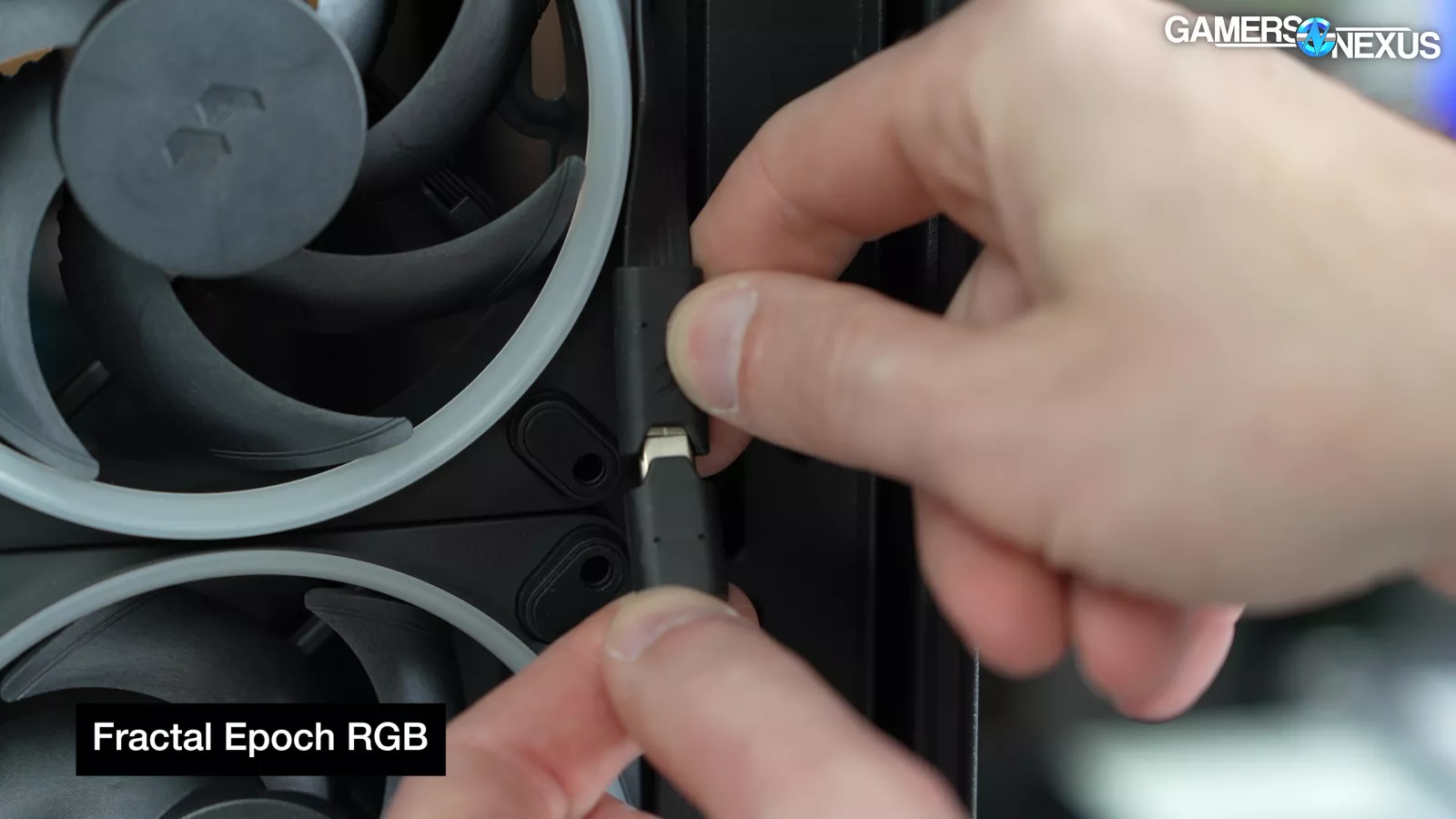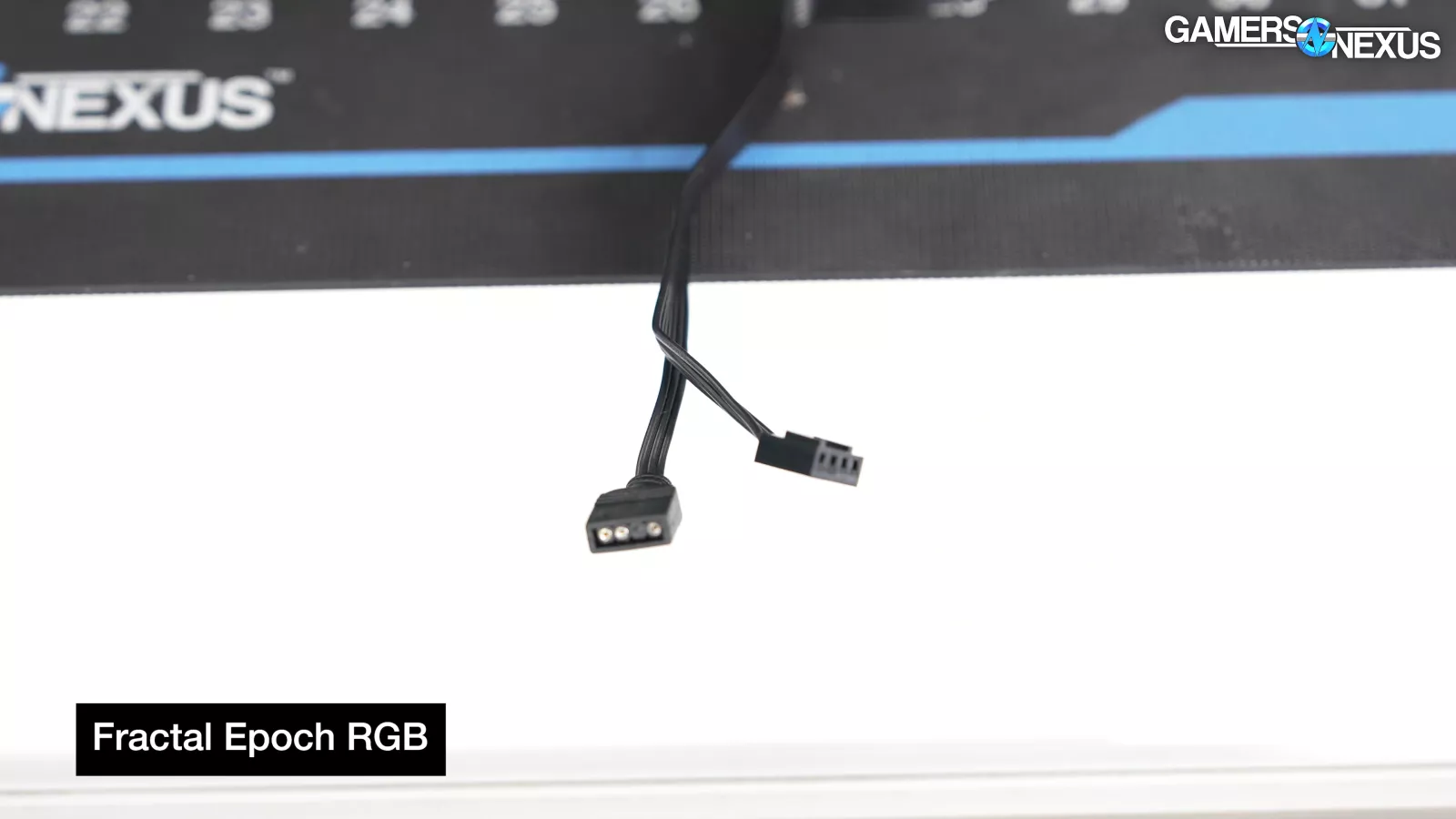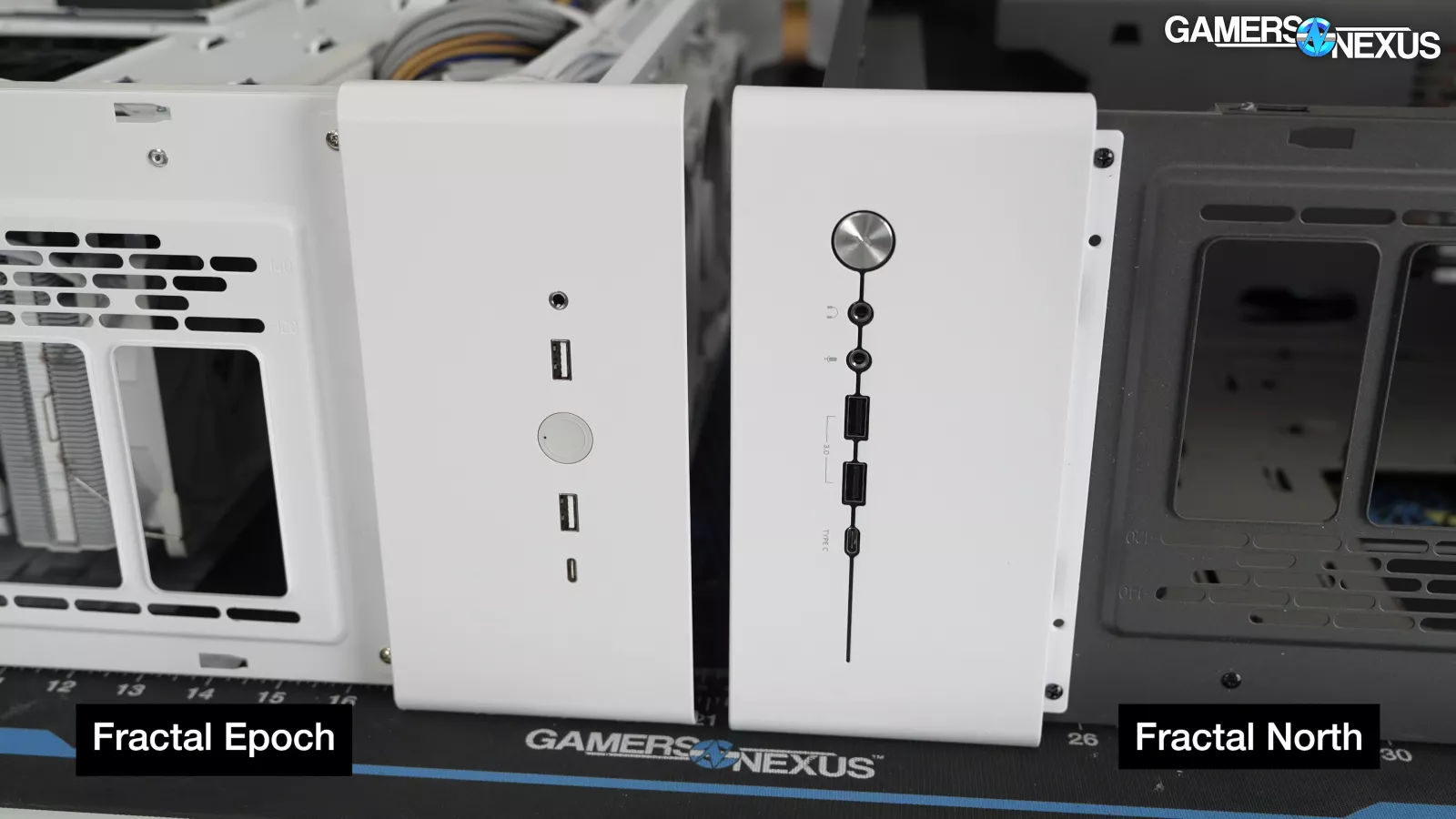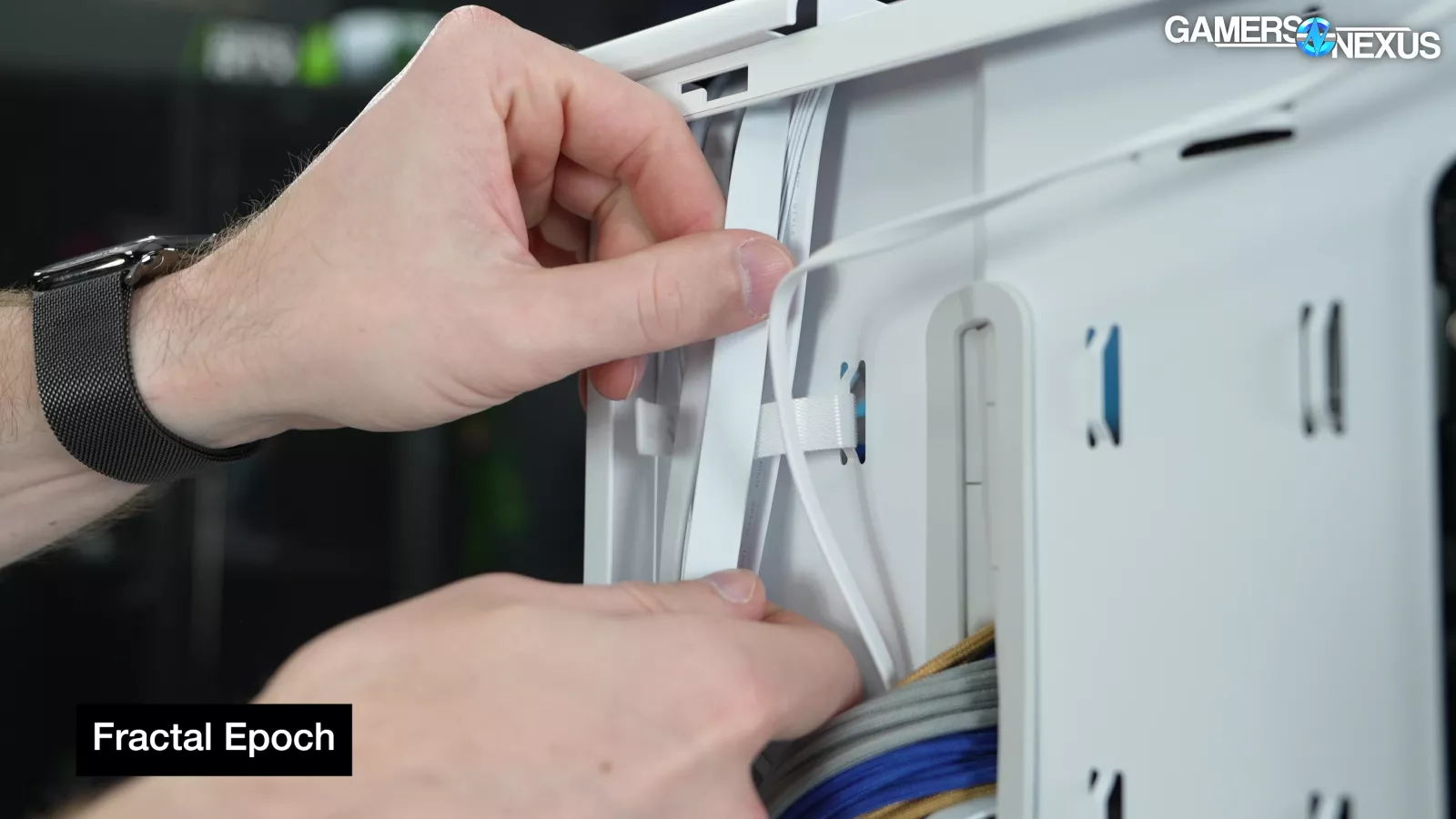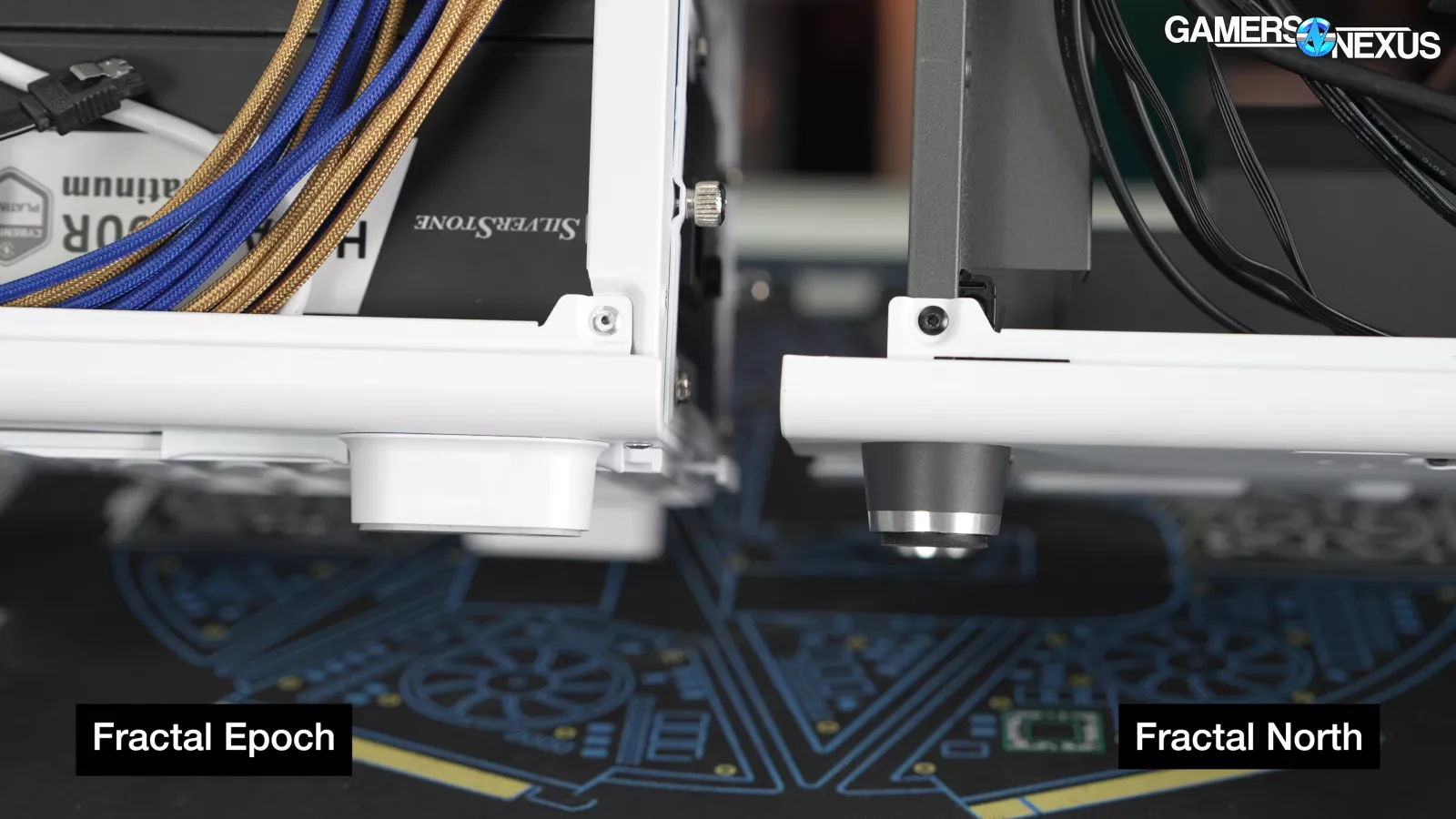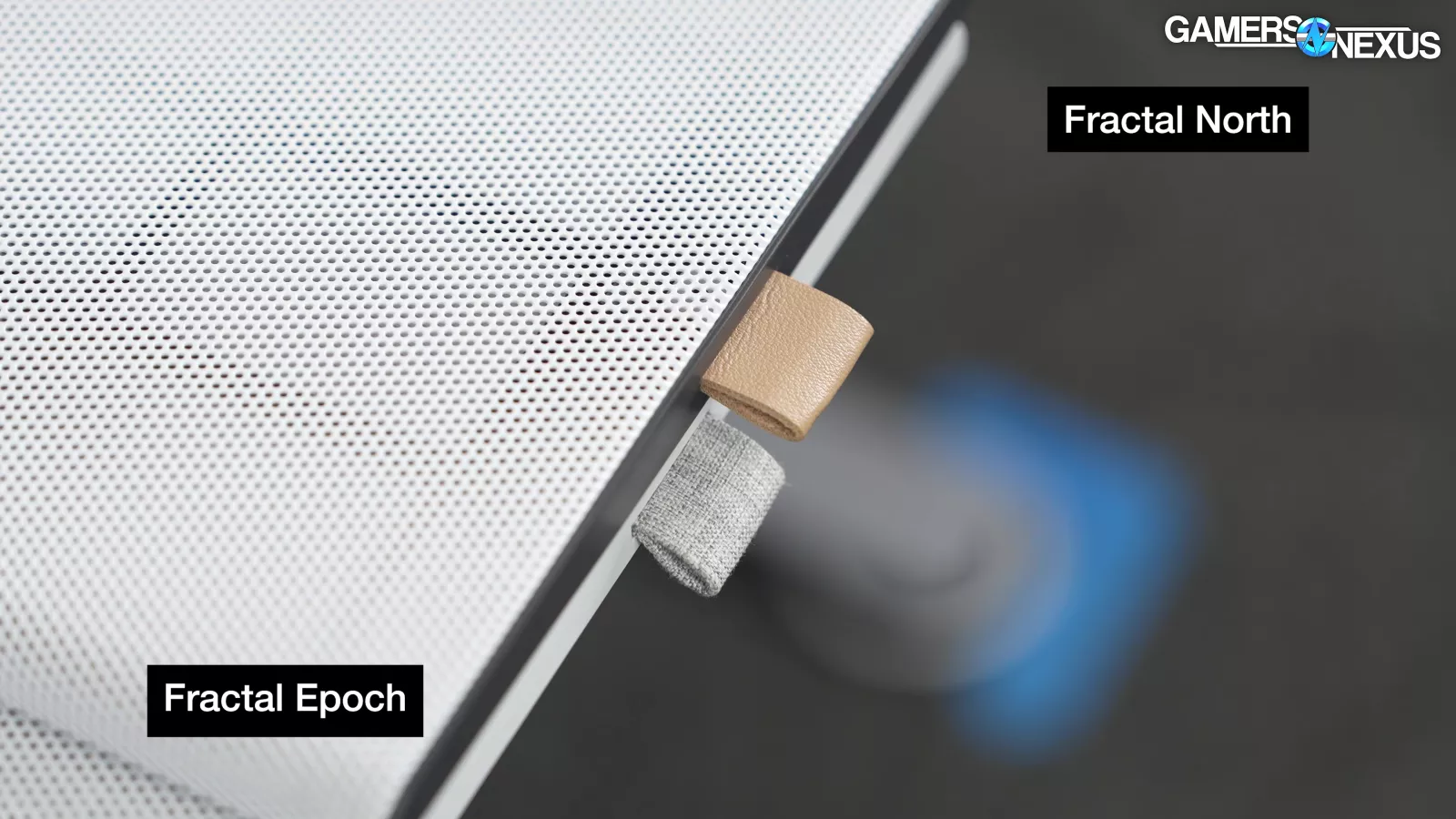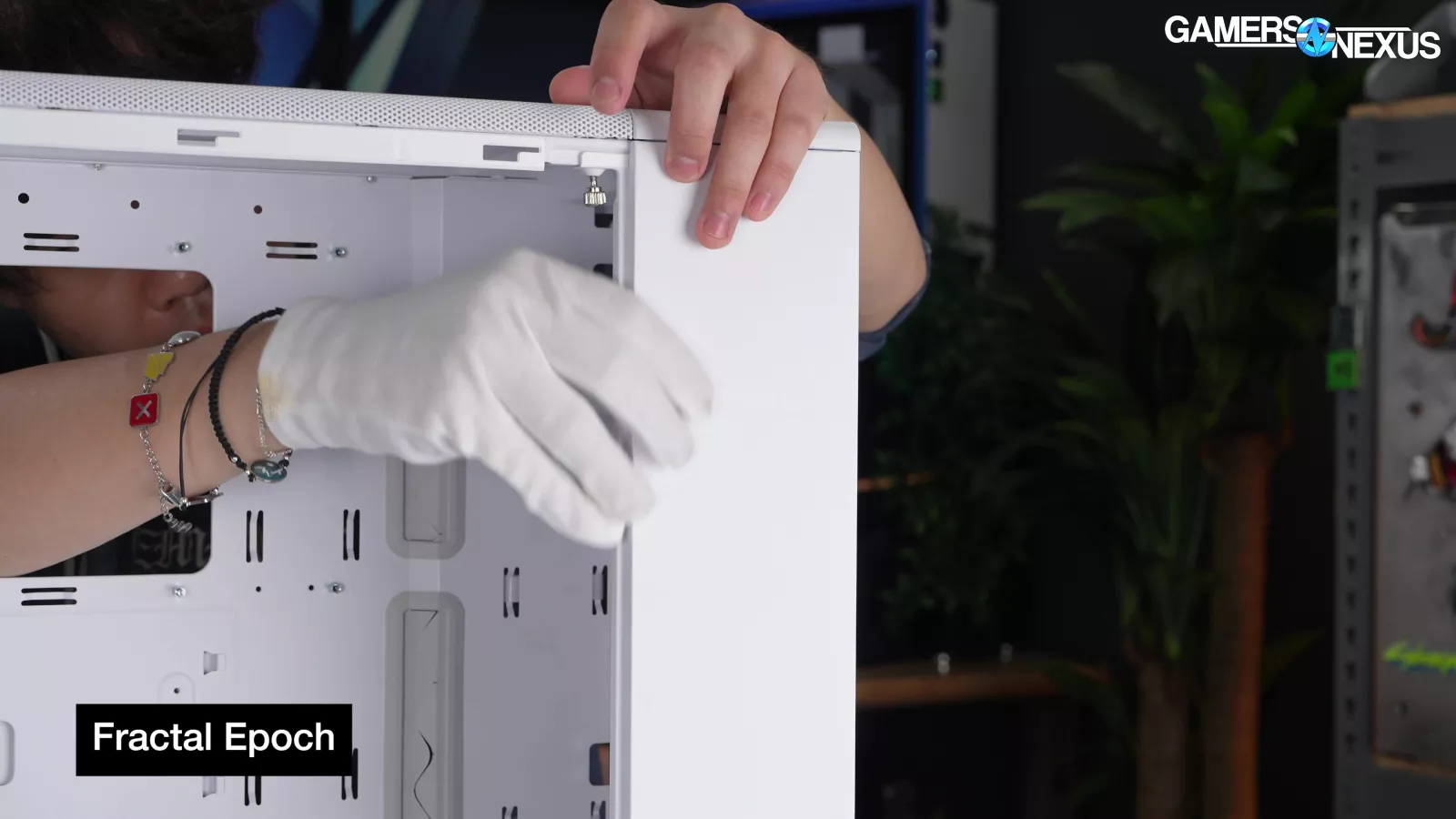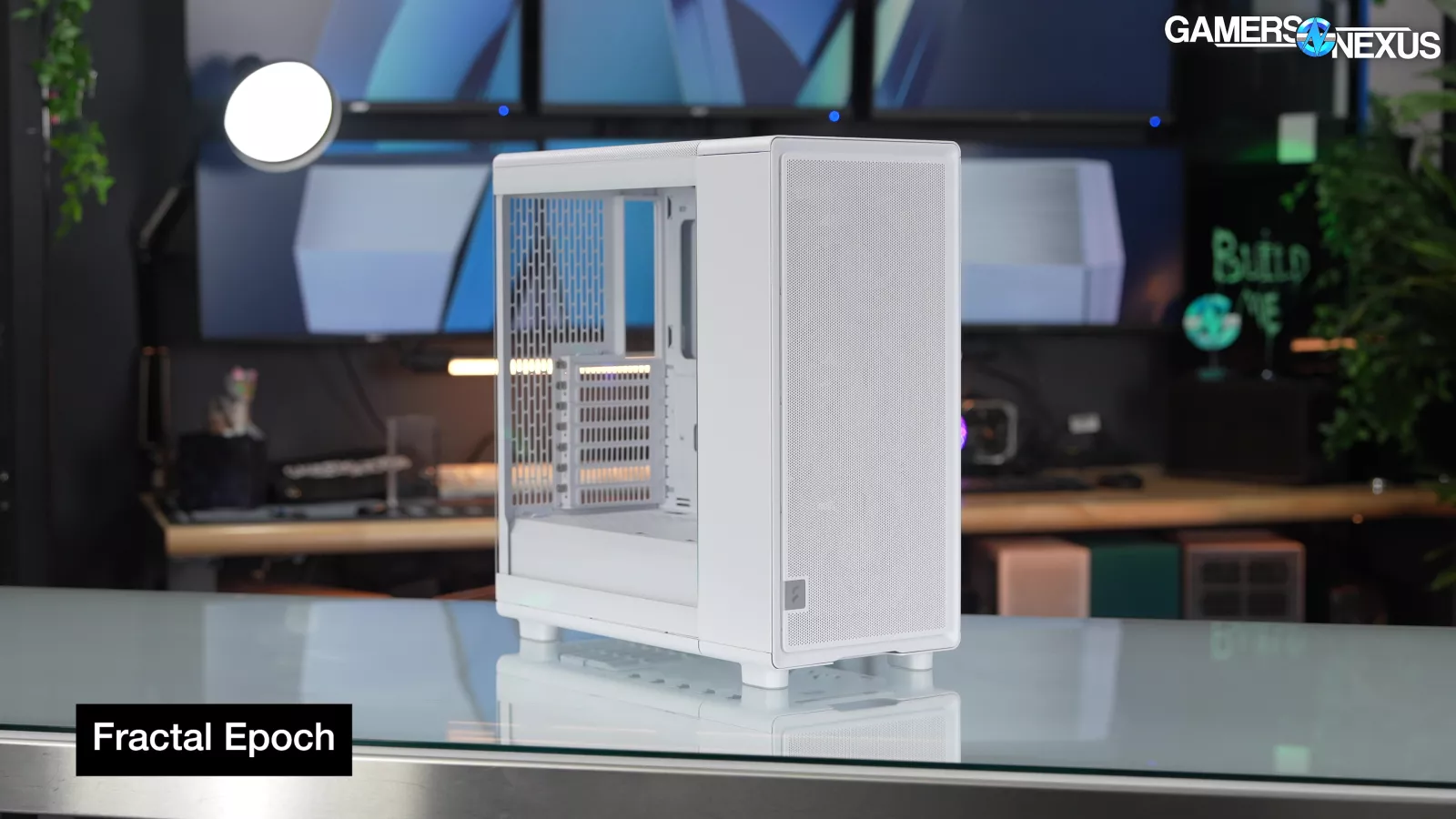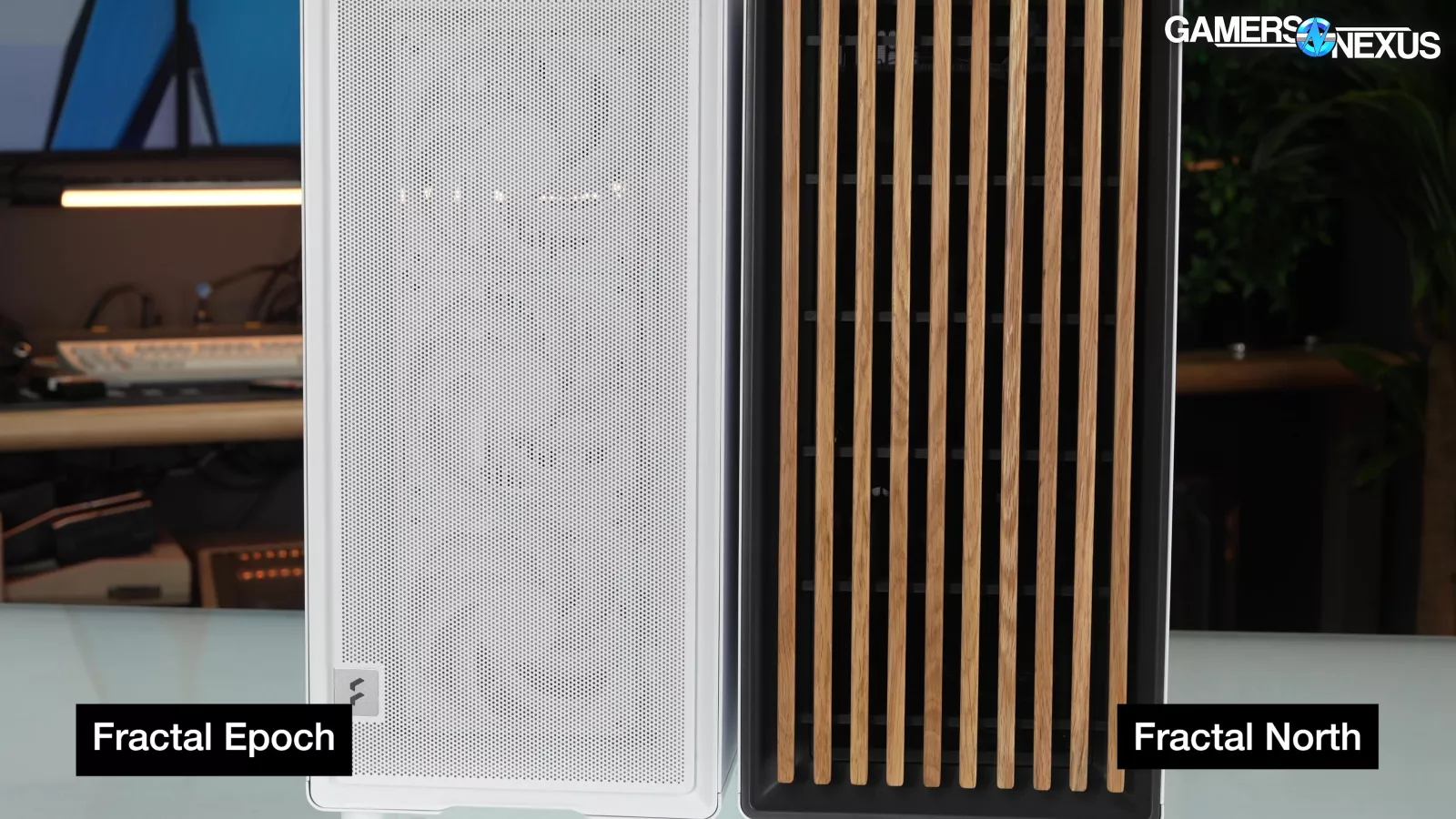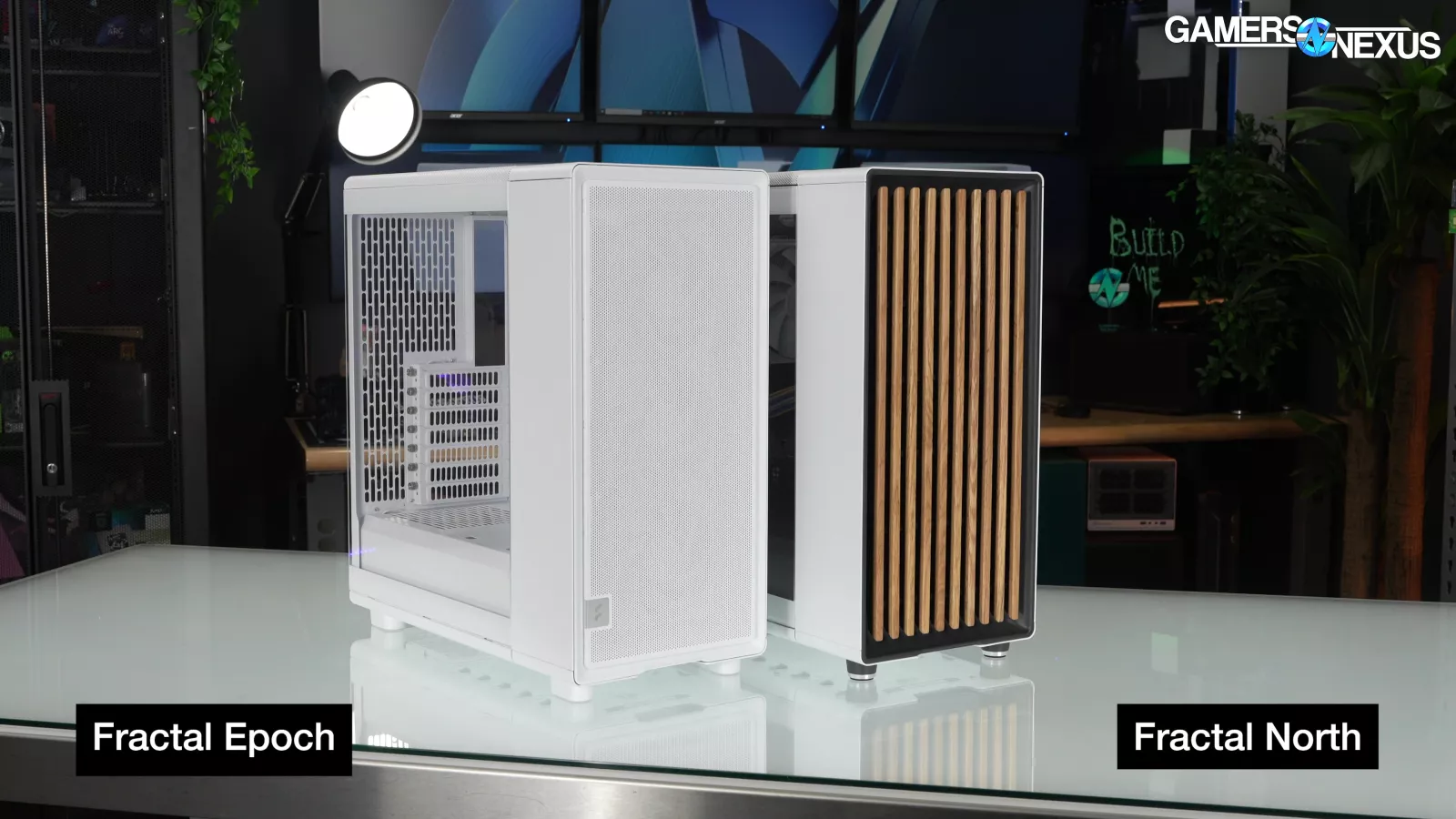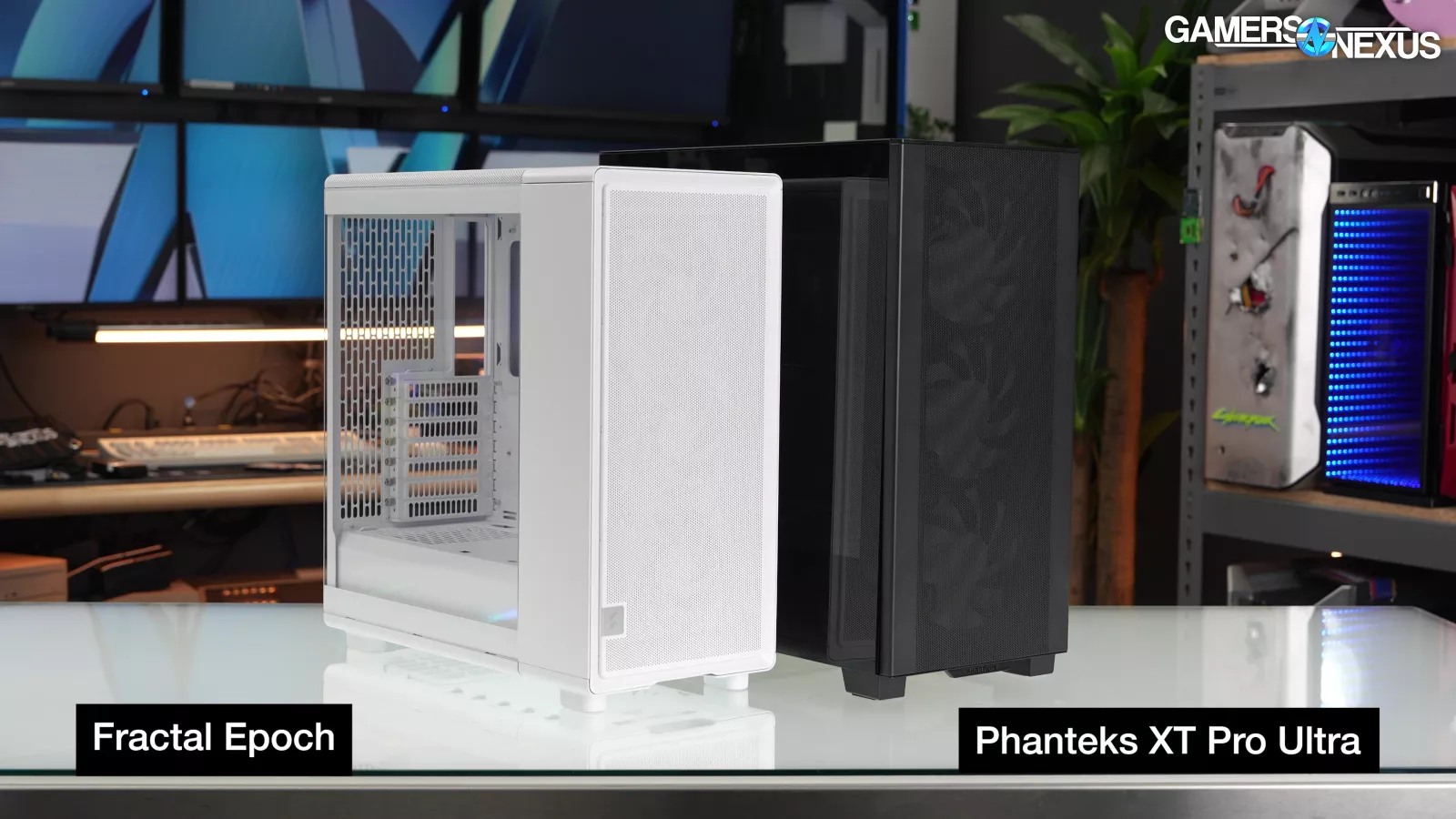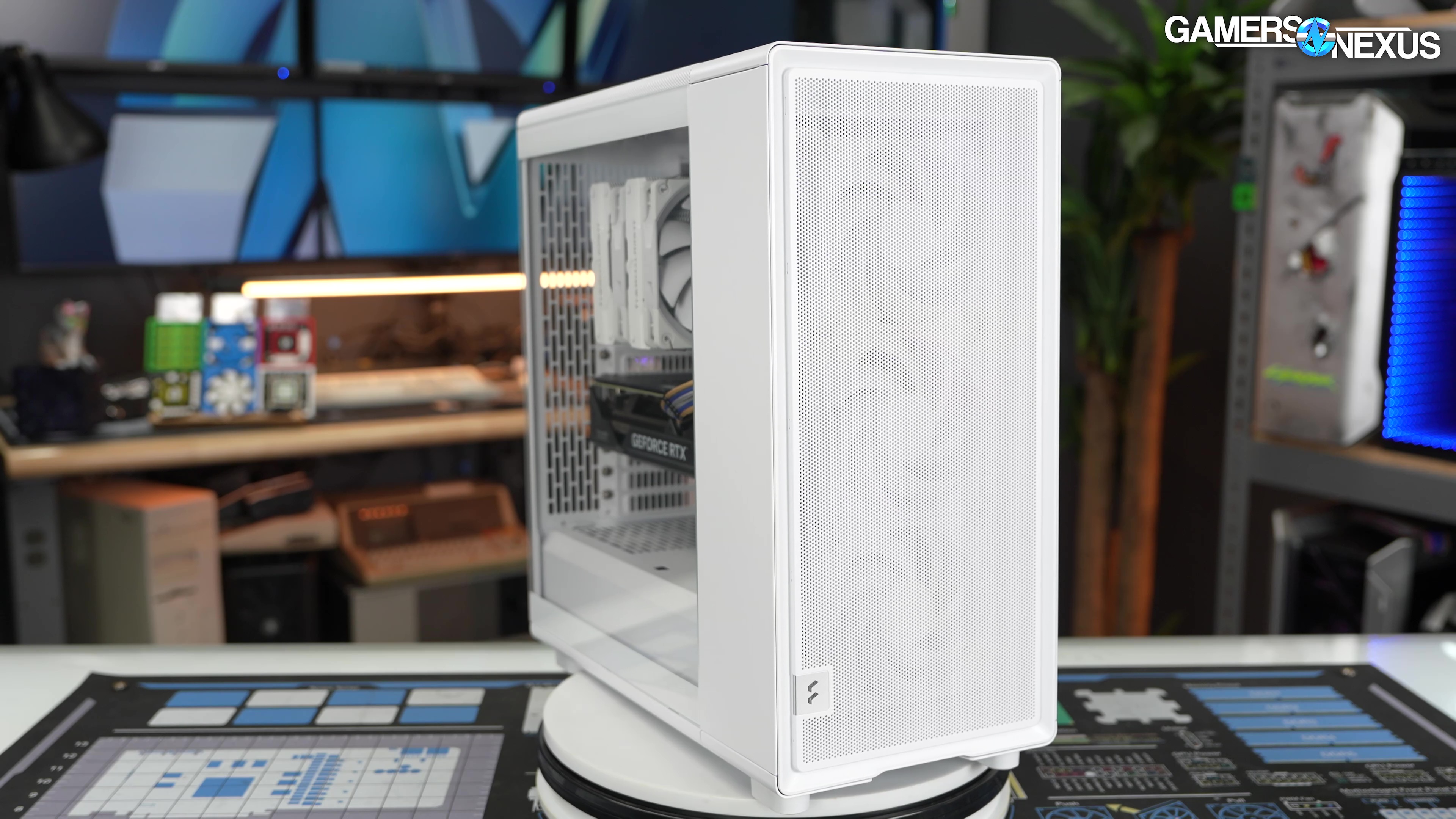
We analyze the Fractal Epoch PC case against some of the best computer cases on the market.
The Highlights
- Fractal's Epoch computer case builds upon the Fractal North chassis, but swaps the front panel to accommodate larger GPUs while driving the price down
- At its price range, we’d buy something else
- The Epoch aims to be more price competitive than Fractal's other modern offerings, helping breathe life into the price category that the Pop Air has occupied
- Original MSRP: $110 MSRP ($130 for RGB)
- Release Date: September 2025
Table of Contents
- AutoTOC
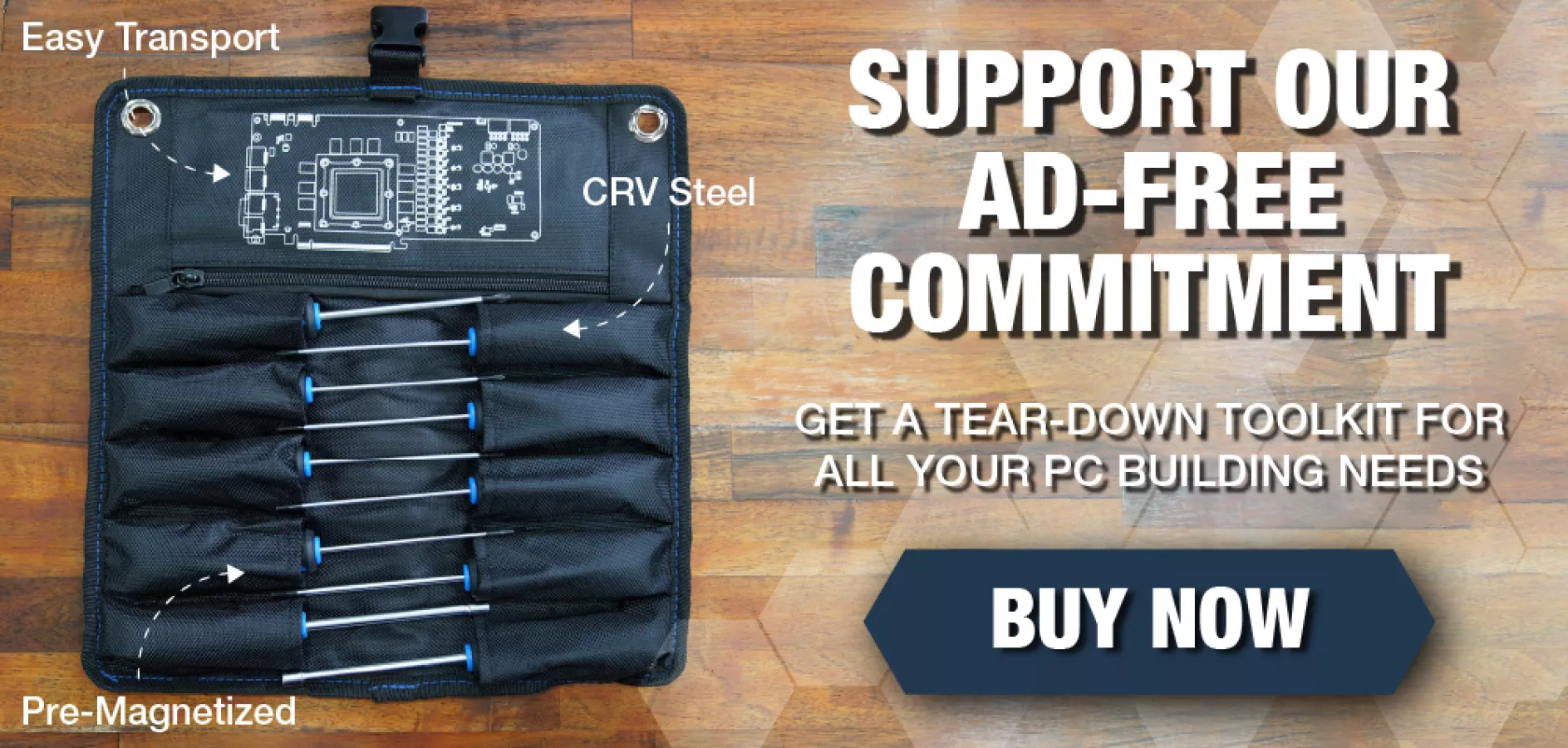
Intro
The Fractal Epoch is the Fractal North (watch our review) with a new front panel and a lower price. That makes this simple, except for one massive problem: The name. According to Google, this is pronounced the Epic. According to the Cambridge dictionary, it’s either the E-poch, eh-pock, or epic.
Editor's note: This was originally published on September 2, 2025 as a video. This content has been adapted to written format for this article and is unchanged from the original publication.
Credits
Test Lead, Host, Writing
Steve Burke
Testing, Writing
Patrick Lathan
Camera, Video Editing
Vitalii Makhnovets
Camera
Tim Phetdara
Writing, Web Editing
Jimmy Thang
Fractal's newest case reuses a ton of tooling from the popular North in order to keep costs low, resulting in a $110 MSRP ($130 for RGB). The Epoch's front panel increases GPU clearance without making the case any larger than the compact North it's based on. The new design also comes with 3 stock fans versus the North's 2, so we'll cover the differences in thermal performance in detail, as well as noise testing.
The North itself originally launched at $130, then went to $140, and is now $154. This is almost definitely due to tariffs. With the Meshify 3 (read our review) going for $155 minimum as well, the Epoch fills a budget slot in Fractal's lineup that hasn't really been updated since the Pop Air (watch our review) and Focus 2 came out in 2022.
Today then, we’re reviewing and benchmarking the Fractal Epoch for thermals and acoustics.
| 3.5"/2.5" drive mounts | 3 (2 included) |
| Dedicated 2.5" drive mounts | 2 |
| 5.25” drive mounts | 0 |
| Expansion slots | 7 |
| Motherboard compatibility | ATX / mATX / Mini-ITX |
| Power supply type | ATX |
| Front interface | 1x USB Type-C 20Gbps2x USB Type-A 5Gbps1x Audio/Mic Combo Jack |
| Total fan mounts | 6 x 120 mm or 4 x 140 mm |
| Front fan | 3 x 120/2x 140 mm(# 3 x Momentum 120mm PWM included) |
| Top fan | 2 x 120/140 mm |
| Rear fan | 1 x 120 mm |
| Bottom fan | N/A |
| Dust filters | PSU |
| Front radiator | Up to 360mm; Up to 280mm |
| Top radiator | Up to 240mm |
| Rear radiator | 1x 120mm |
| Bottom radiator | N/A |
| PSU max length | 1 HDD Tray: 255mm max2 HDD Tray: 155mm max |
| GPU max length | 372 mm with front fan mounted; up to 345mm with front mounted radiator. |
| CPU cooler max height | 170 mm |
| Cable routing space | 30 mm |
| Cable routing grommets | Yes |
| Fixed velcro straps | Yes |
| Tool-less push-to-lock | Thumb screws for side panels, PSU bracket, ball joints front panel and sliding lock top mesh. |
| Captive thumbscrews | HDD brackets, SSD brackets, Side panels, PSU bracket |
| Left side panel | Tempered glass 3 mm [or] Steel |
| Right side panel | Steel |
| Case dimensions (LxWxH) | 447 x 215 x 469 mm |
| Case dimensions w/o feet/protrusions/screws | 443,3 x 215 x 455,3 mm |
Specs copied from manufacturer materials, please read review for our own measurements and opinions
The Build
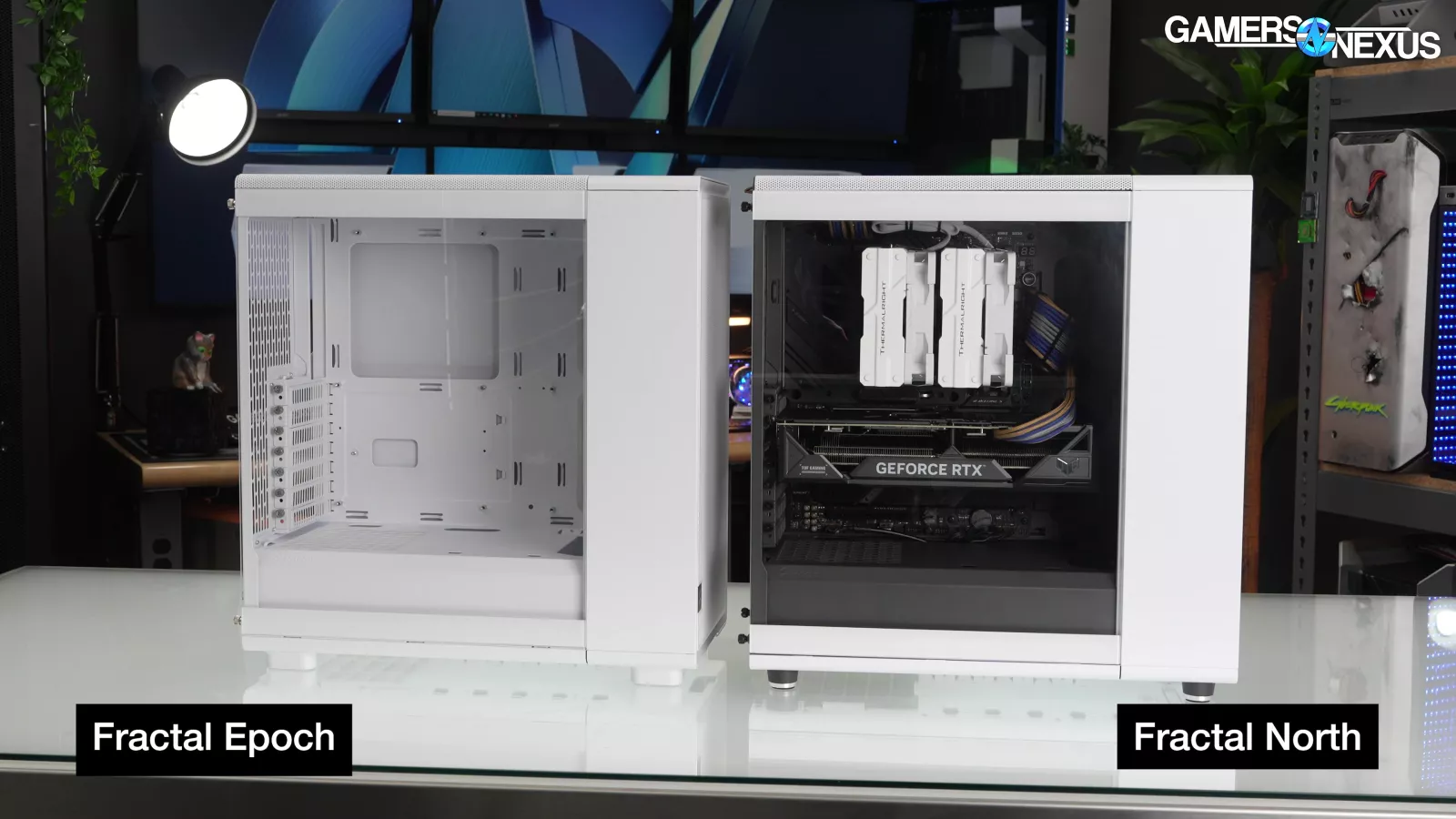
The build experience in the Epoch is largely the same as it is in the North, but we'll recap some details here. We like the North overall, but at launch, we stated that the North felt like it should be $20-$40 cheaper if it weren't for the wood in the front panel. We also said the wood elevated the case and (arguably) made it worth the price.
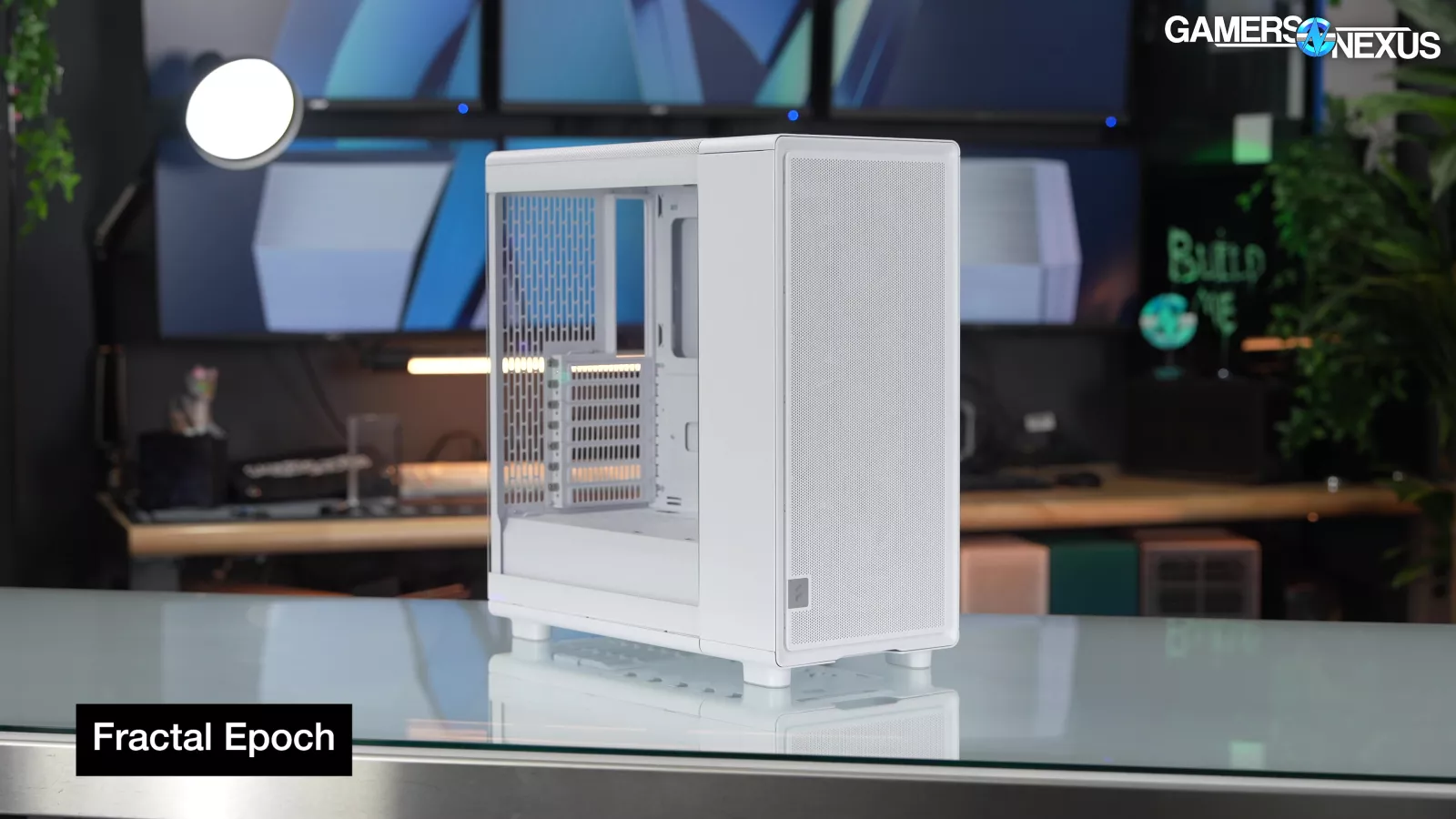
The Epoch lacks wood and it's $20-40 cheaper than the North is currently, so that lines up with the earlier statements. The only challenge is that it’s $30-$40 cheaper than the North’s new price, which is higher.
The Epoch (like the North) is fairly basic. Removing the two-part side panel and the sliding mesh top panel gives good access to the case interior, but there's a clear divide between the Epoch and something like the more expensive Meshify 3, which has fully removable top and front mounts that completely open up the case.
The North's shallow form factor means that GPU clearance is limited to 355mm, which would mash the end of the GPU directly against the front fan mounts. The front of the Epoch has been reworked to push the front fans further into the front panel, hence the listed 372mm GPU clearance. Updating this for the Epoch was worthwhile, although it seems more likely that people are going to try to fit big, expensive GPUs into the North or North XL rather than the plainer Epoch.
The redesign also means that the new case has more clearance for fans and radiators between the PSU shroud and the fan bracket, up from 36mm to 58mm by our measurements, and there's less material overhanging the front drive bracket. The only downside we noticed with the front panel redesign is that fan cables need to be managed more carefully to avoid getting in the way.
The new design is simpler, with the metal mesh at the front of the Epoch acting as a filter rather than the removable filter in the North. We’ve found that this is better thermally (and in the past, we’ve found in testing that noise-normalized, it’s also superior). You’ll just wipe the front panel down instead.
Our main complaints with the North boiled down to cable management, which was lacking compared to competitors even at the time. That’s because the deeper channel at the front of the case is 3cm deep at most, which can lead to the side panel bulging with poor cable management and a lot of cables, especially since the side panel doesn't hook into the case along that edge.
It's not an insurmountable problem, which is good, because the Fractal Epoch is exactly the same in that regard.
The cutout for CPU power connectors is also a little on the small side, and the interior of the PSU shroud can get crowded if both drive trays are used. These space issues are a little more forgivable in the North because the North XL exists as an alternative, but we aren't aware of plans for an Epoch XL.
A couple of features from the North have been removed, presumably to cut costs. There's currently no mesh side panel option for the Epoch, which also means that there's no side fan bracket (and no mounting holes to install one). There's also no built-in fan hub, but Fractal has handled this by daisy-chaining fans in both case variants.
As we saw in the Meshify 3, Fractal uses Type-C shaped connectors (NOT actual USB) for its RGB Momentum fans, but the RGB Epoch uses an adapter that splits out into standard fan and RGB connections.
Otherwise, the differences are neutral cosmetic details.
The front I/O has been rearranged, the illuminated strip from the North is gone, and the two audio jacks have been combined into one. The USB ports are of the same type and quantity, but the Type-C port is now connected with a flat ribbon cable. The case feet have been redesigned without metal accents (the Epoch's might still be more expensive since each is a unique shape), and the faux-leather pull tab at the back of the case has been replaced with fabric. The captive screw on the half-panel at the front of the case still gets wedged, just like the North, but at this point, we've had to make peace with that.
Fractal Design Epoch Thermals

For thermal testing, we ran one set of tests with the stock non-RGB case, then moved the RGB fans into that same case and ran another set of tests to ensure every other variable remained exactly the same.
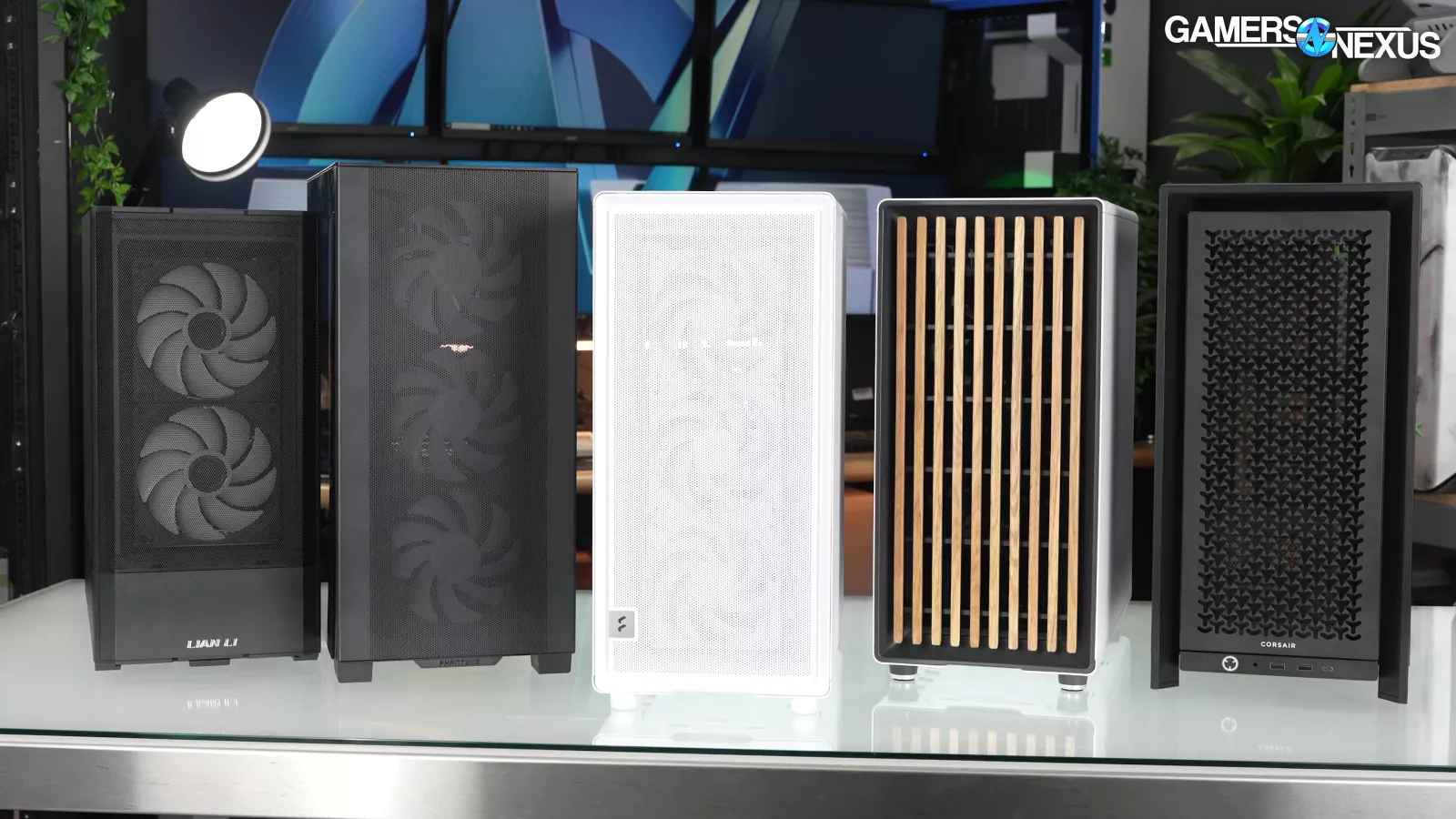
Of the cases we've tested lately, the direct comparisons for the Epoch are the Corsair Frame 4000D RS, Phanteks XT Pro Ultra, the Lian Li Lancool 207 (or arguably the 217), and of course Fractal's own North. These are all fairly compact ATX towers in the $90-$110 range, with the Epoch landing at the upper end of that and the North being the highest of all of them.
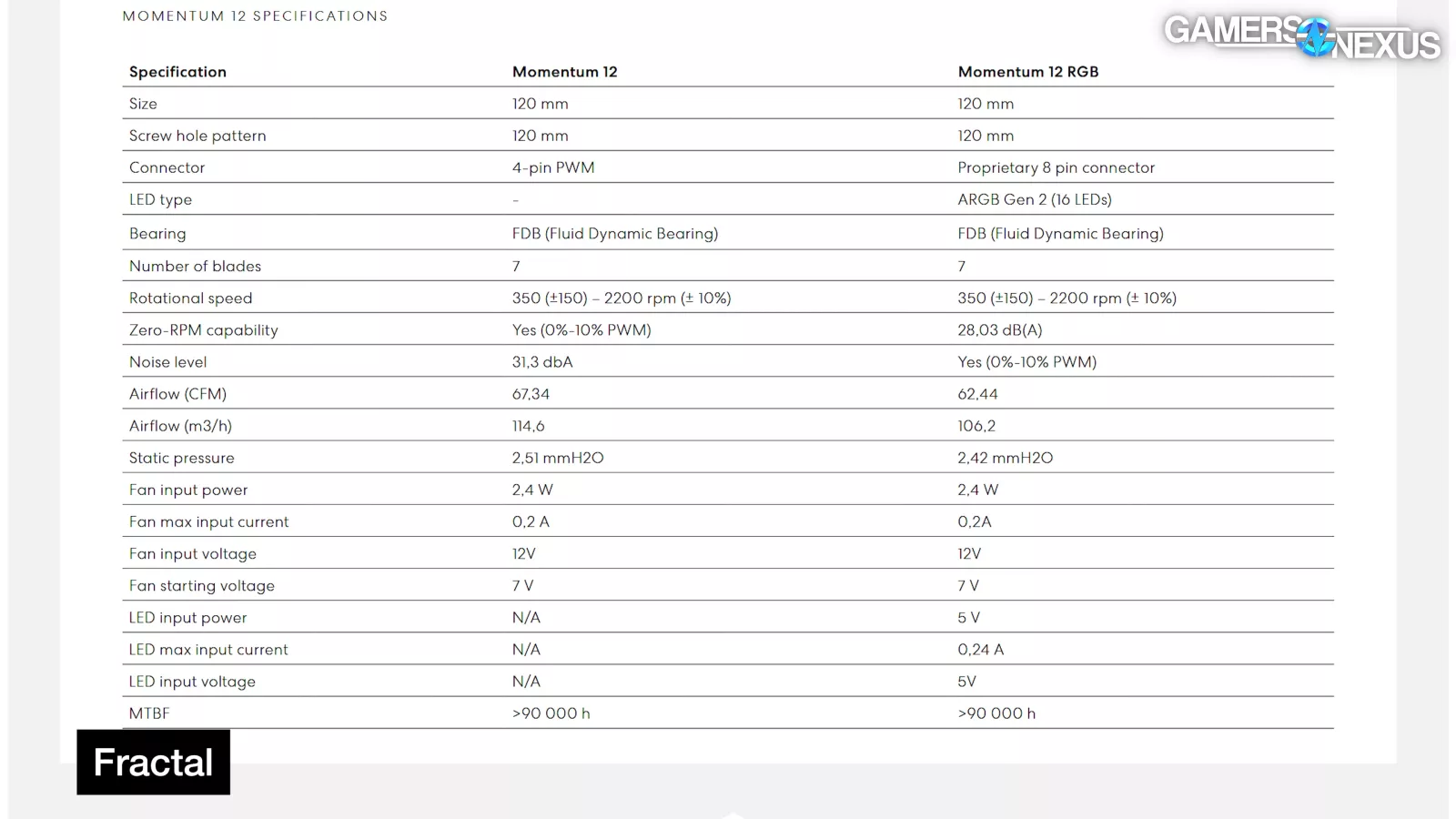
The non-RGB Epoch will be our main point of comparison since the RGB version costs $130 and could have slightly worse thermal performance. According to the spec sheet, just like with the Meshify 3, the non-RGB fans can generate more noise and move more air at peak speed. Now we have an opportunity to actually test for differences, although they should be minor, and the rated RPM is 2200 for both models.
CPU Full Load Thermals - Noise-Normalized
We'll start with our noise-normalized test, where we adjust the speed of the stock case fans to hit an overall SPL of 27 dBA as measured in our hemi-anechoic chamber. We built this chamber to allow more accurate testing and normalization by eliminating external noises that may affect day-to-day noise floor.
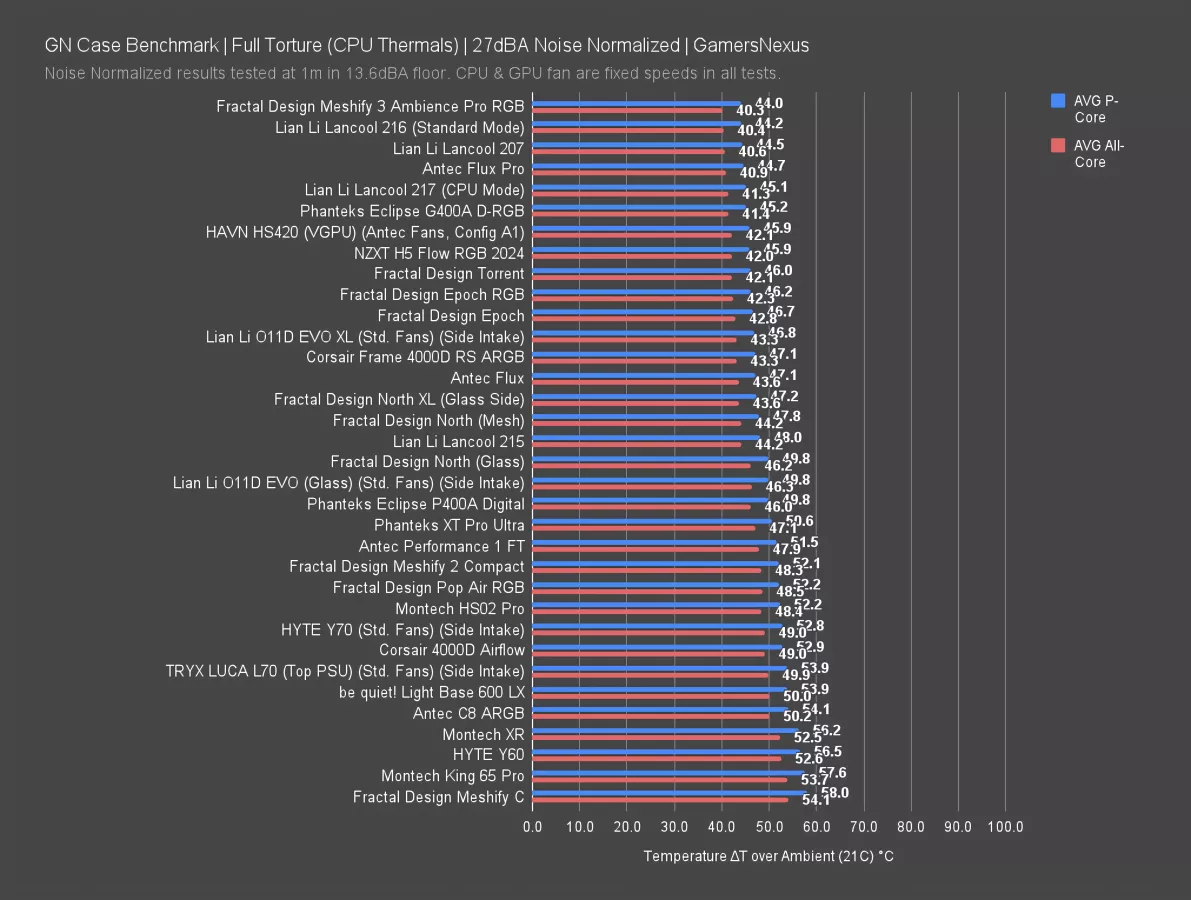
With a full-system torture workload, CPU temperature in the Epoch was 43 degrees Celsius above ambient for the all-core average and 47 degrees on the P-cores, and the temperatures with RGB fans were within one degree for both measurements for the 2 cases. Fractal's claim is that the non-RGB fans are a little louder and higher CFM, which could mean that our noise normalization reverses or equalizes for performance differences.
The Epoch outperformed the original North, which came with two 140mm fans and averaged 46 degrees above ambient all-core and 50 degrees P-core. The glass-sided North is more similar to the Epoch, but the mesh option is an advantage for the case, lowering the all-core average to 44 degrees above ambient and 48 degrees over ambient P-core.
The Phanteks XT Pro Ultra was even warmer than the glass North, which means the Epoch is also better than the XT Pro Ultra. The Corsair Frame 4000D RS was within error of the Epoch and functionally the same, which makes sense given the similar layout and fan arrangement. The most serious competition comes from Lian Li's dirt-cheap Lancool 207 (read our review) with its 41 degree average, as well as the more expensive 217 (read our review), also at 41. These cases are at about 45 degrees for the P cores.
GPU Full Load Thermals - Noise-Normalized
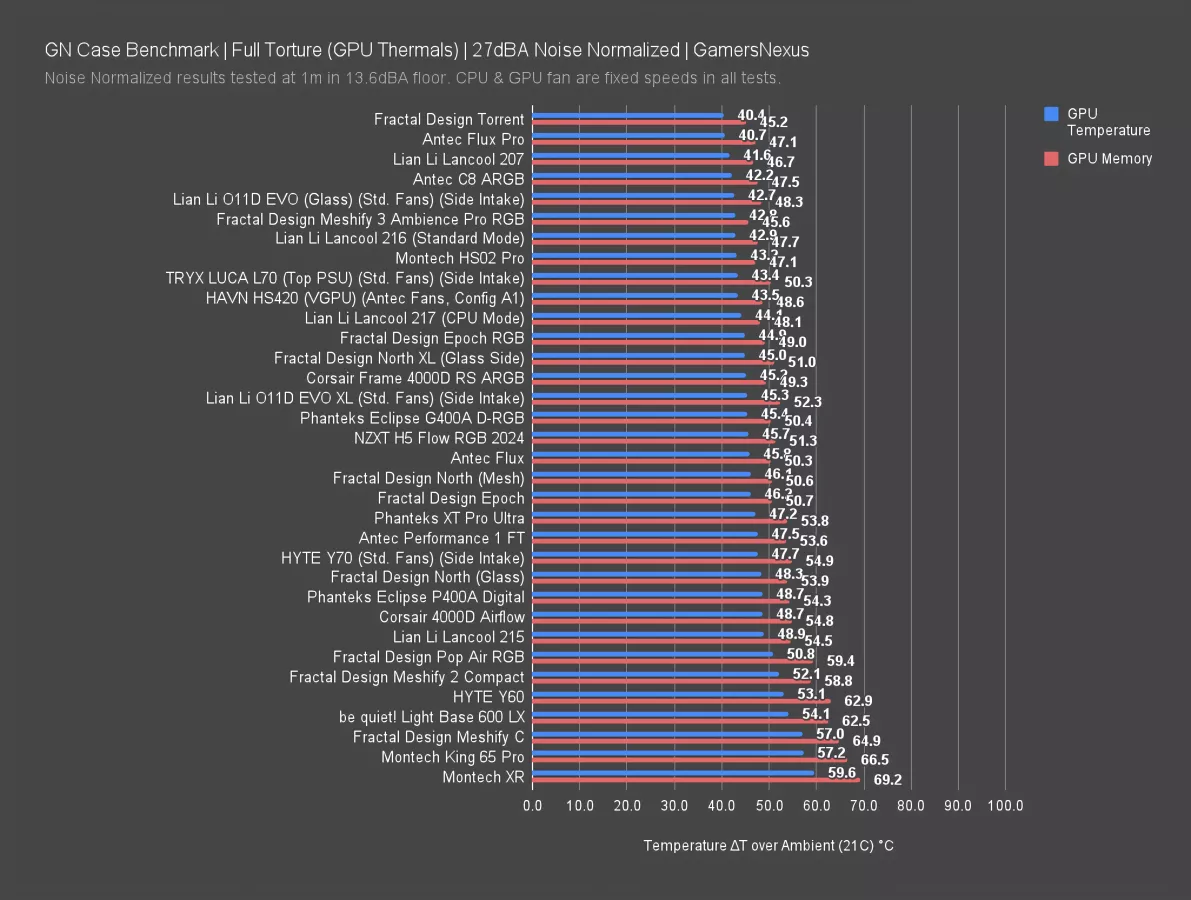
Moving to GPU thermals in the same test, the Epoch RGB averaged 45 degrees above ambient and the regular Epoch averaged 46. Memory temperatures showed a slightly wider delta, with the Epoch RGB at 49 and Epoch at 51. The regular Epoch was louder at max speed, so it required a greater fan speed reduction to hit our noise-normalized threshold, which explains the temperature difference in combination with a +/-1 degree range.
The regular Epoch outperformed the glass North's 48-degree average and tied the mesh North at 46. The Phanteks XT Pro Ultra came closer to the Epoch here than it did for CPU thermals, although the memory temperature was a weak point for the Phanteks case at 54 degrees over ambient.
The Frame 4000D did well with a 45 degree GPU average, while the Lian Li cases again are ahead, with the 207 and 217 "GPU Mode" showing similar performance at 42 degrees above ambient on the GPU. Credit to Fractal for still having the best GPU thermal performer with the Torrent (read our review) though, tying the Flux Pro (read our review). These are much more expensive cases.
GPU Full Load Thermals - Full Speed
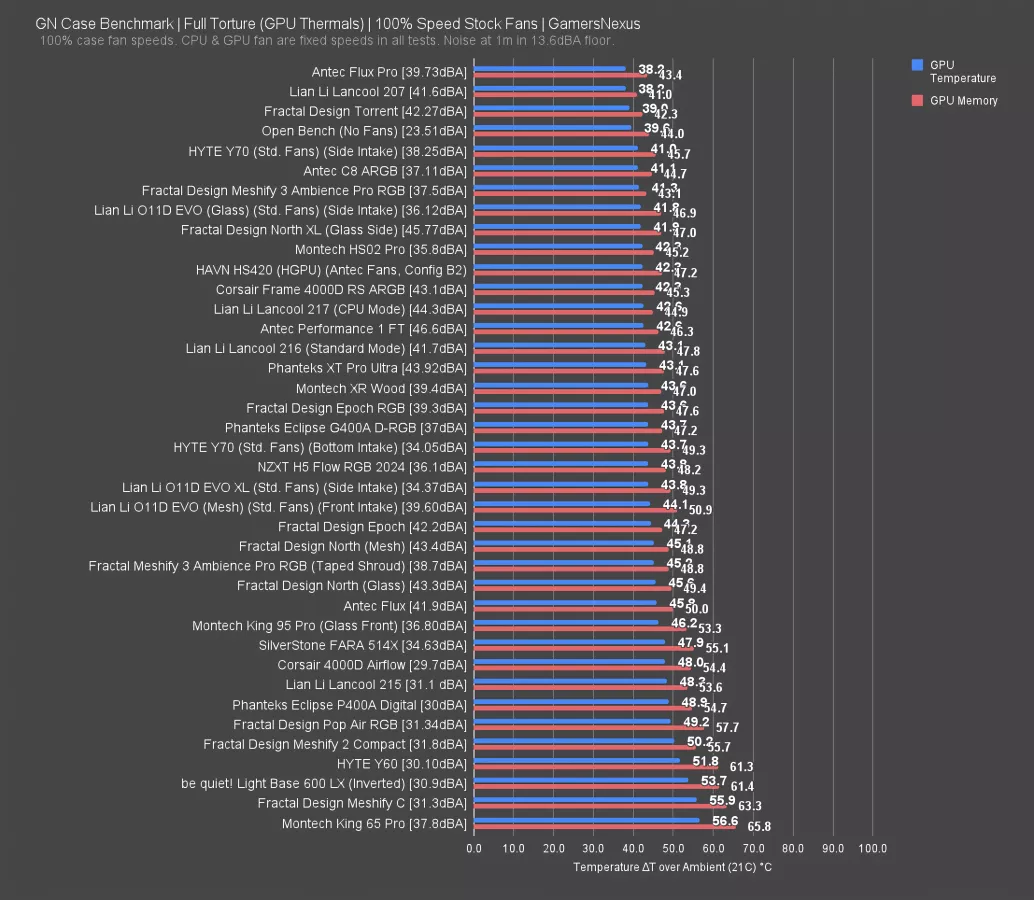
We’re switching to full speed tests now, which means we allow noise to become a variable. The noise level is next to the case name.
At full speed, the non-RGB and RGB cases didn't show much of a difference in thermal performance, but they did in noise. The stock Epoch with non-RGB fans measured 42.2 dBA, while the RGB case measured 39.3 dBA. That lines up with Fractal's claims, which have a regular Momentum 12 at 31.3 dBA and a Momentum 12 RGB at 28.03 dBA in their testing. These hard numbers are different because they are tested in different environments and methods -- we’re measuring total system noise, not just the fans.
The average GPU temperature with the RGB fans in the Epoch was technically lower at 43.6 degrees average, but not enough to be outside the margin for error, and the average GPU memory temperatures were nearly identical between RGB and non-RGB.
The North with its stock fans almost kept up, with the mesh-sided result only one degree warmer and the glass-sided result at 46 degrees above ambient, although noise levels were higher than the Epoch. Each of the other competitor cases we mentioned performed better, though, starting with the XT Pro Ultra at 43 degrees, then the Frame 4000D at 42, the Lancool 217 at 39-40 in an ideal configuration, and finally the Lancool 207 at 38 degrees above ambient and roughly the same noise level as the Epoch.
Noise levels have the Epoch about the same as the Antec Flux Pro when at max fan speed, with the Flux Pro running far cooler with its superior fans. The Flux Pro is also $165 to $180, depending on promos, so it’s not the same price class.
GPU Full Load Thermals - Standardized Fans

Using our standardized set of two 140mm intake fans and one 120mm exhaust allows us to make a true head-to-head comparison between the North and Epoch front panels, without stock fans as a variable.
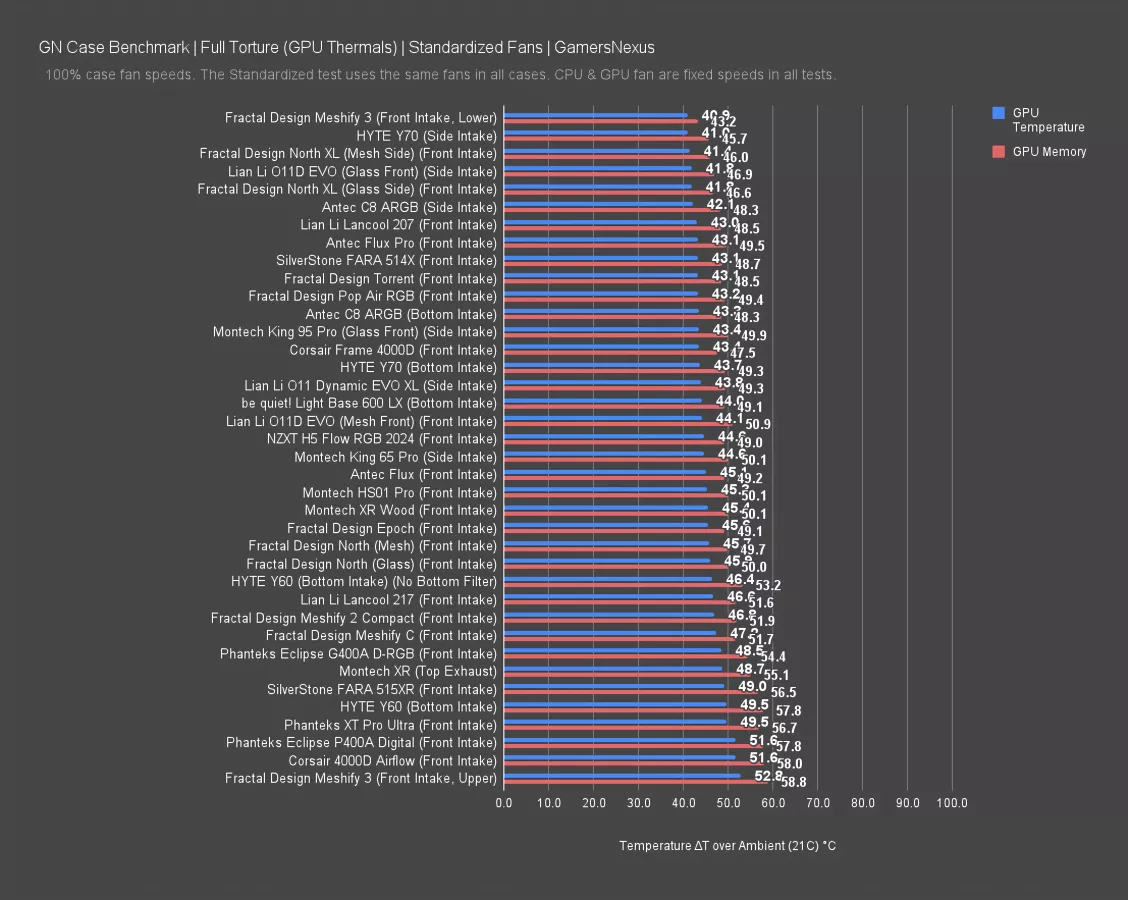
In terms of GPU thermals, the Epoch, the mesh-sided North, and the glass-sided North all averaged the same: 46 degrees above ambient. The Epoch's front panel may be cheaper, but it's not worse for thermals.
CPU Full Load Thermals - Standardized Fans
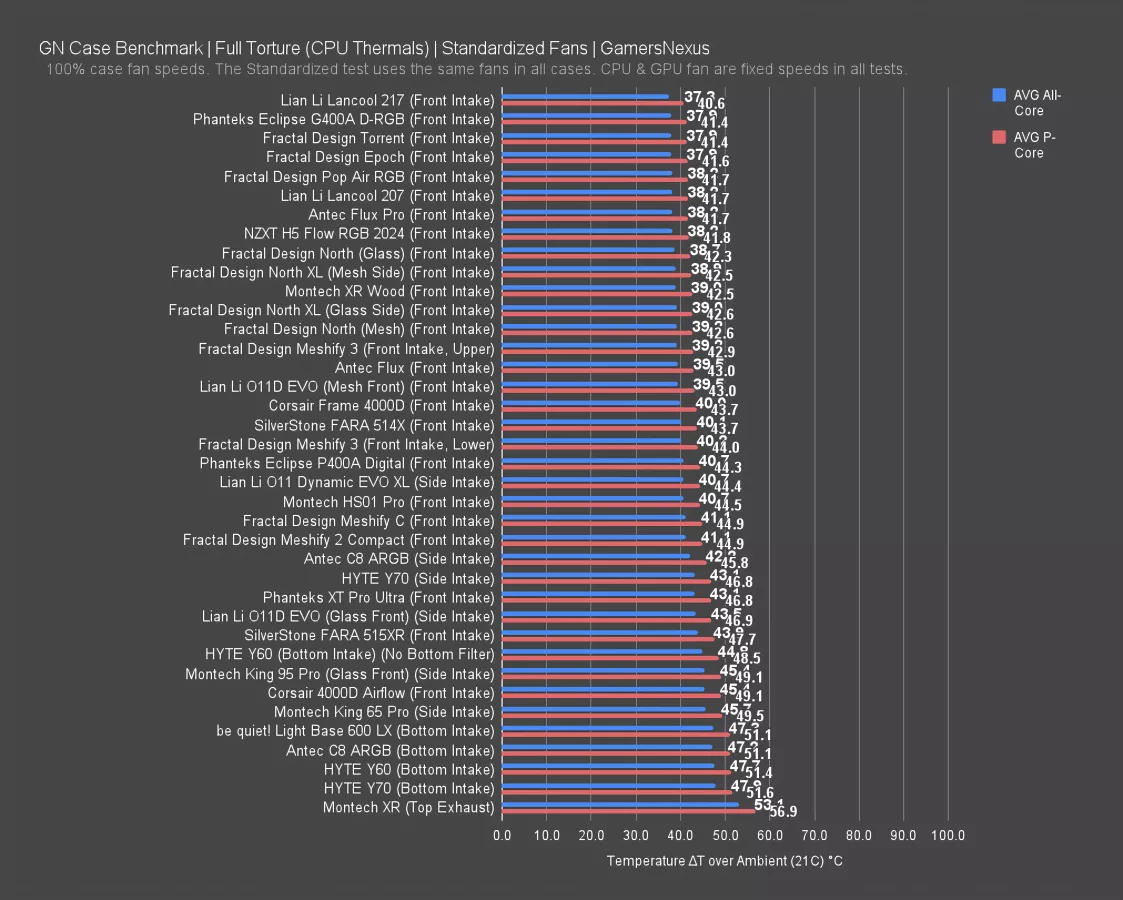
CPU thermals between the two North variants in the standardized fan test were also very similar, but the Epoch was about one degree cooler, averaging 38 degrees above ambient all-core and 42 on the P-Cores alone. The new front panel seems to be slightly more open, but any further performance advantages for the Epoch are down to its stock fans.
VRM & RAM Full Load Thermals - Noise-Normalized
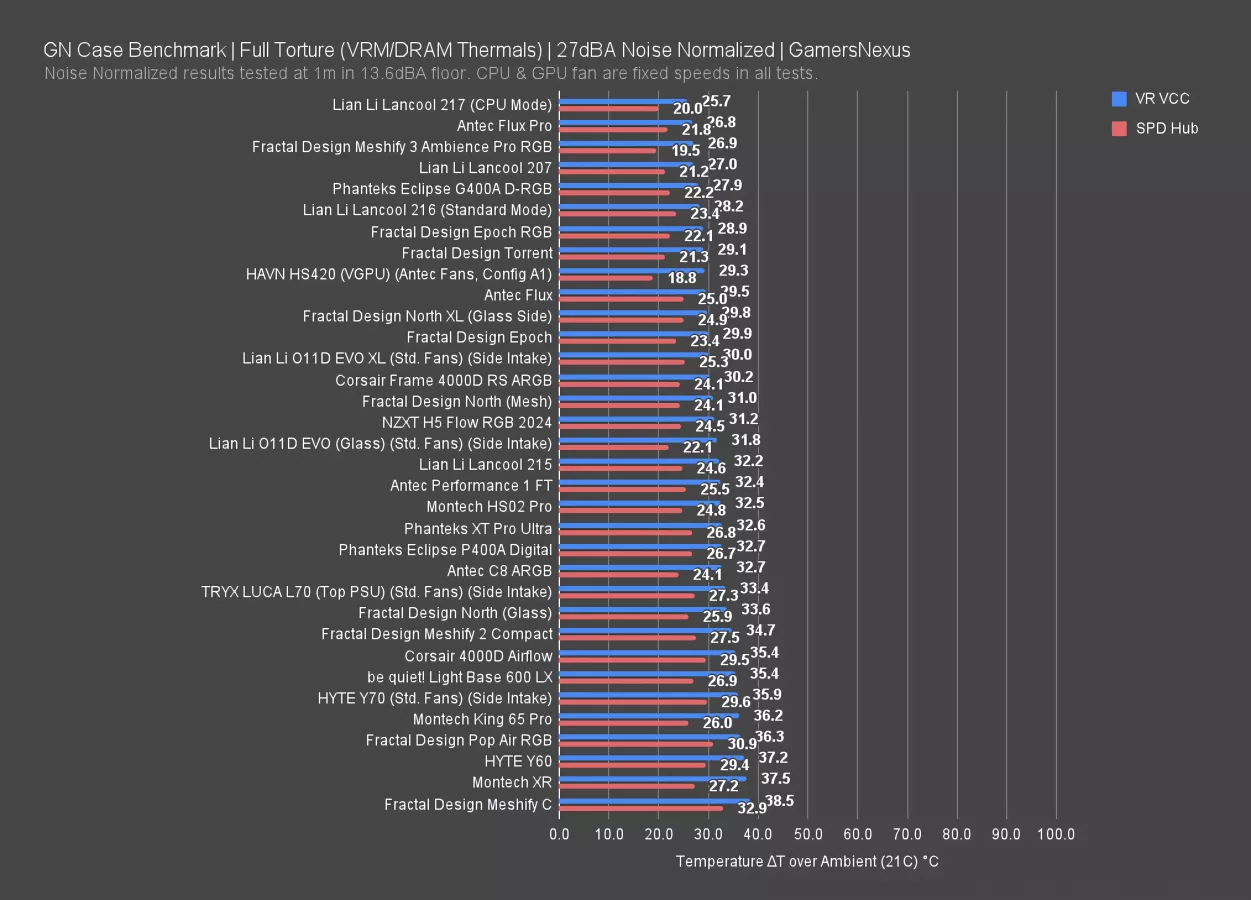
Back to the noise normalized test, the Epoch RGB's VRM temperature averaged 29 degrees above ambient and the regular Epoch averaged 30. That's better than either North variant, but 217 remains top of the chart at 26 degrees.
Fractal Design Epoch Conclusion
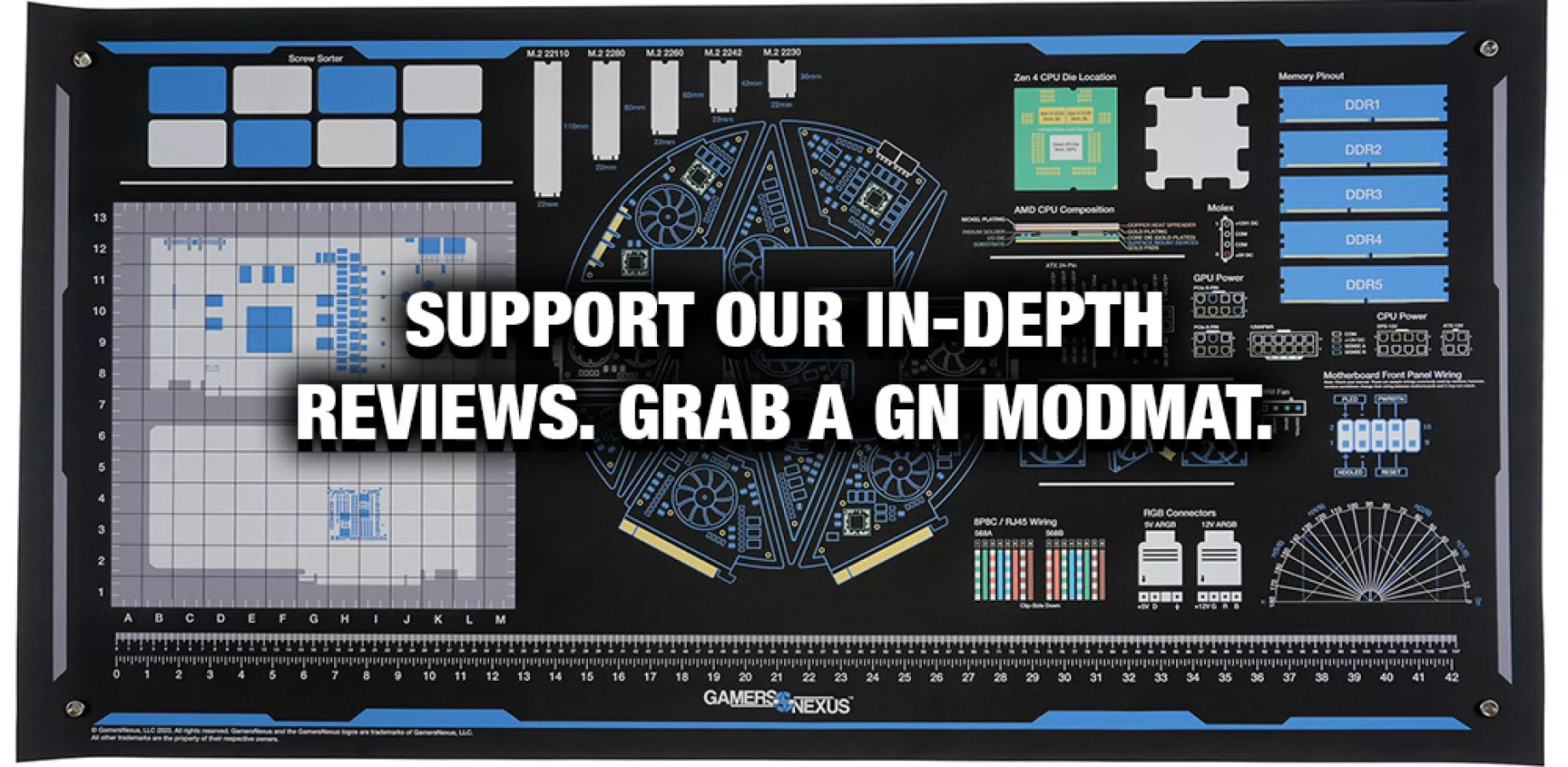
The Epoch is entering a market where every dollar counts. This is a harder market to compete in than the $150-$180 range.
We think $110 is at the upper limit of what Fractal can realistically ask for this model. It's a North without the wood, and while the trendsetting wood accents will keep the North selling even at $140+, a North without the wood is a reliable but unexciting compact mid-tower, even if the performance is a little better and there's a little more GPU clearance.

Fractal has steep competition from Corsair, Phanteks, and Lian Li, among others.
Corsair's Frame 4000D RS (the one with three stock fans) is basically the same thing as the Epoch, and as of this writing, it's on sale for $95. We weren't terribly impressed with the Phanteks XT Pro Ultra's thermal performance, but it's currently even cheaper at $80 after a rebate on Newegg. The most ruthless competition is from Lian Li, as usual, with its cutthroat prices. It's selling its wood-trimmed Lancool 217 for as little as $120, but a more direct comparison for the Epoch is the $82 compact Lancool 207, and even the 207 Digital with an integrated LCD is on sale for $105.
It’s good that Fractal is updating its budget offerings because it hasn’t had a refresh here in a couple years, but there's not a particularly strong reason other than brand loyalty to choose the Epoch over its cheaper competition. The North is a good case, but it’s primarily good because of the front panel and the optional mesh side panel. The Epoch is the North without either of those, leaving it as simply “fine.” It’s OK. But competing in the lower price classes, we’d buy something else.
